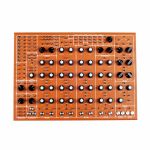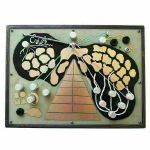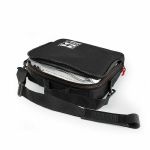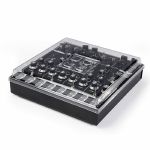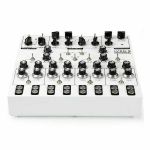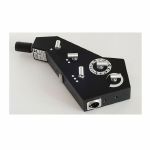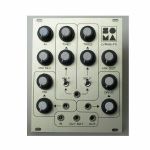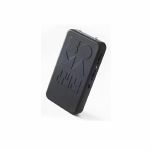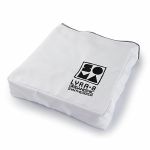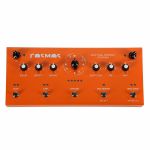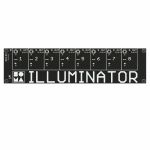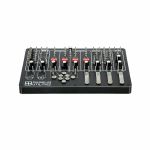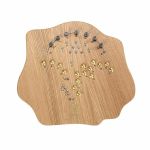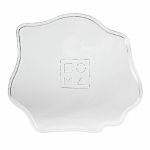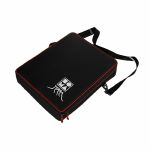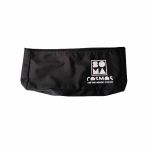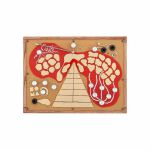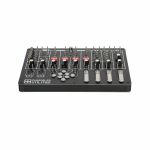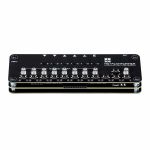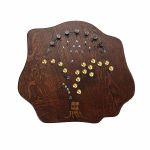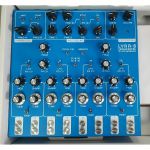安全购物
Studio equipment
Our full range of studio equipment from all the leading equipment and software brands. Guaranteed fast delivery and low prices.
安全购物
DJ equipment
Our full range of DJ equipment from all the leading equipment and software brands. Guaranteed fast delivery and low prices. Visit Juno DJ
Receive new release alerts for Soma Laboratory
Filter
Stock
Equipment
Format
Featured
Price
Tags
Items 1 to 25 of 25 on page 1 of 1
Soma Laboratory Pulsar-23 Organismic Drum Machine (orange) (drum machine)
Cat: 855508 Rel: 23 Nov 21
A multi-functional analogue synthesiser and generator of complex rhythmic patterns.
Notes: PULSAR-23 is an organismic drum machine designed by Vlad Kreimer. It has a semi-modular structure and consists of 23 independent modules. PULSAR can be used for the synthesis of percussion instruments and rhythms, bass and melodic lines, effects and sound landscapes, as well as a source of control voltage and powerful analog FX processor.
The PULSAR functions in three different modes: stand-alone, MIDI control and CV control. Moreover, all the above features and control modes can work simultaneously in any proportion or combination.
Additionally, PULSAR offers live circuit bending capabilities and the use of the artist's body conductivity to create patches and cross modulations. PULSAR continues the line of organismic synthesizers begun by LYRA-8, but now in the area of percussion instruments.
Also, it has MIDI control and synchronization and a lot of smaller modules such as 4 assignable attenuators and 2 dynamic CV sensors for CV generation etc. In general, there are 55 knobs, 11 switches and over 100 inputs and outputs for patching, Eurorack integration, external mixing and processing, live circuit bending!
It comes in a special HQ bag with 30 alligator clips cables and PSU.
PULSAR available in orange, black and white colours.
Please note that Pulsar is an experimental analog synth that means that it has some small noise and bleeds that can't affect your studio production or live performance but can be hearable in some modes. If you need a perfect silence and isolation of sound modules, using digital hardware is 100% recommended.
Specs
Range of input and output CV and audio signals: 0 to + 10V
Main output voltage swing: 2V
1/4 inch jack: 7 total
Mini-jack (for Eurorack connection): 8 total
MIDI input: standard DIN socket
Headphone output: 3.5 mm mini-jack
Supply voltage: 12 volts (plus in the center)
Consumption current: 0.3 amperes
Weight: 4 kg
Dimensions: 380 x 280 x 80 mm
What's in the box:
PULSAR-23
PSU
22 multi-colour cables with alligator clips 65cm
8 multi-colour cables with alligator clips 30cm
High-quality handmade bag for transportation
… Read moreThe PULSAR functions in three different modes: stand-alone, MIDI control and CV control. Moreover, all the above features and control modes can work simultaneously in any proportion or combination.
Additionally, PULSAR offers live circuit bending capabilities and the use of the artist's body conductivity to create patches and cross modulations. PULSAR continues the line of organismic synthesizers begun by LYRA-8, but now in the area of percussion instruments.
Also, it has MIDI control and synchronization and a lot of smaller modules such as 4 assignable attenuators and 2 dynamic CV sensors for CV generation etc. In general, there are 55 knobs, 11 switches and over 100 inputs and outputs for patching, Eurorack integration, external mixing and processing, live circuit bending!
It comes in a special HQ bag with 30 alligator clips cables and PSU.
PULSAR available in orange, black and white colours.
Please note that Pulsar is an experimental analog synth that means that it has some small noise and bleeds that can't affect your studio production or live performance but can be hearable in some modes. If you need a perfect silence and isolation of sound modules, using digital hardware is 100% recommended.
Specs
Range of input and output CV and audio signals: 0 to + 10V
Main output voltage swing: 2V
1/4 inch jack: 7 total
Mini-jack (for Eurorack connection): 8 total
MIDI input: standard DIN socket
Headphone output: 3.5 mm mini-jack
Supply voltage: 12 volts (plus in the center)
Consumption current: 0.3 amperes
Weight: 4 kg
Dimensions: 380 x 280 x 80 mm
What's in the box:
PULSAR-23
PSU
22 multi-colour cables with alligator clips 65cm
8 multi-colour cables with alligator clips 30cm
High-quality handmade bag for transportation
1 in stock $1,676.77
Cat: 856138 Rel: 24 Dec 21
A multi-functional analogue synthesiser and generator of complex rhythmic patterns.
Notes: Blue version of Soma's weird and wonderful 'organismic' semi-modular synth. Ideal for drum and percussion synthesis but also suitable for melodic sounds, FX and more. Unique.
Supplier's Notes:
Pulsar-23 is a multi-functional analog synthesizer and generator of complex rhythmic patterns.
The Pulsar consists of 23 different modules, including four flexible sound generators with completely different structures, four envelope generators, four looper-recorders, a clock generator with dividers, a controlled chaos generator, an LFO, a two-channel CV-controlled effects processor, distortion, two controlled amplifiers, an inverter, a controlled inverter and two controlled analog switches. In addition to these 23 main units, the Pulsar also contains 13 auxiliary units, such as a four-channel MIDI to CV converter, a noise generator, four attenuators, two dynamic CV generators with sensory control, two impulse converters and single passive electronic components for live circuit bending.
Pulsar-23 can be used for the synthesis of percussion instruments and rhythms, bass and melodic lines, effects and sound landscapes, as well as a source of control voltage. The Pulsar functions in three different modes: stand-alone, MIDI control and CV control. Moreover, all the above features and control modes can work simultaneously in any proportion or combination. Additionally, Pulsar offers live circuit bending capabilities and the use of the artist's body conductivity to create patches and cross modulations.
Pulsar continues the line of organismic synthesizers begun by LYRA-8, but now in the area of percussion instruments.
Also, it has MIDI control and synchronization and a lot of smaller modules such as 4 assignable attenuators and 2 dynamic CV sensors for CV generation etc. In general, there are 55 knobs, 11 switches and over 100 inputs and outputs for patching, Eurorack integration, external mixing and processing, live circuit bending!
It comes in a special HQ bag with 30 alligator clips cables and PSU.
… Read moreSupplier's Notes:
Pulsar-23 is a multi-functional analog synthesizer and generator of complex rhythmic patterns.
The Pulsar consists of 23 different modules, including four flexible sound generators with completely different structures, four envelope generators, four looper-recorders, a clock generator with dividers, a controlled chaos generator, an LFO, a two-channel CV-controlled effects processor, distortion, two controlled amplifiers, an inverter, a controlled inverter and two controlled analog switches. In addition to these 23 main units, the Pulsar also contains 13 auxiliary units, such as a four-channel MIDI to CV converter, a noise generator, four attenuators, two dynamic CV generators with sensory control, two impulse converters and single passive electronic components for live circuit bending.
Pulsar-23 can be used for the synthesis of percussion instruments and rhythms, bass and melodic lines, effects and sound landscapes, as well as a source of control voltage. The Pulsar functions in three different modes: stand-alone, MIDI control and CV control. Moreover, all the above features and control modes can work simultaneously in any proportion or combination. Additionally, Pulsar offers live circuit bending capabilities and the use of the artist's body conductivity to create patches and cross modulations.
Pulsar continues the line of organismic synthesizers begun by LYRA-8, but now in the area of percussion instruments.
Also, it has MIDI control and synchronization and a lot of smaller modules such as 4 assignable attenuators and 2 dynamic CV sensors for CV generation etc. In general, there are 55 knobs, 11 switches and over 100 inputs and outputs for patching, Eurorack integration, external mixing and processing, live circuit bending!
It comes in a special HQ bag with 30 alligator clips cables and PSU.
1 in stock $1,838.01
Soma Laboratory Rumble Of Ancient Times 8-Bit Noise Synthesiser & Sequencer (synthesiser/sequencer)
Cat: 858228 Rel: 07 Jul 22
8-bit noise synthesiser and sequencer
Notes: Another intriguing experimental offering from Soma Labs. ROaT is a digital synth inspired by 80s video games. Four oscillators combine with a sequencer to create drones, soundscapes and glitchy loops.
Supplier's Notes:
Rumble of Ancient Times (RoAT) is an 8-bit noise synthesizer and sequencer inspired by the clever programming of the early PC era when an entire video game would fit on a floppy disk. RoAT is capable of a wide variety of sounds ranging from dense noise scapes to diverse glitching rhythmic patterns. The compact and portable instrument contains many elements that can be combined into surprising musical results.
The "heart" of the synthesizer contains 4 sound oscillators, each with a tunable waveform and an individual LFO, which can modulate the tone or volume of the oscillator. The modulated signal of each oscillator is mixed with other signals using 1,536 variations of complex summing algorithms that contain FM, ring modulation, bitwise logical operations and more.
The synth contains an 8-bit resonant lowpass filter with a distinct Lo-Fi character.
The built-in sequencer can be synced to an external device and also send clock out.
RoAT is battery powered and can work up to 130 hours on one set of AAA batteries.
Rumble of Ancient Times is built on a very simple 8-bit microcontroller similar to the ones used in the "brains" of old refrigerators and other simple electronic devices. Thanks to some very clever programming, it's also able to drive a very capable synth with many features!
In stark contrast to modern consumer electronics, this synth celebrates and emphasizes what can be achieved with efficiency of code and using chips considered obsolete by industry leaders. We live in an age where text editors can be 1GB or more and simple things like checking email require the latest OS and powerful processing, despite the core tasks being no different than 15 years ago with a fraction of the computational power.
So RoAT proposes a new kind of ecological thinking with the innovative use of chips that were developed and produced decades ago, instead of turning them into millions of tons of trash. We can still use technology that the industry forced us to consider obsolete, with the added benefit here of extremely low power consumption. It's an environmentally friendlier approach than galloping in the rush of planned obsolescence that damages our planet and wastes precious resources.
Rumble of Ancient Times was designed and programmed by Kakos Nonos, a new creative mind who joined the SOMA development team. His very unique style of building electronic musical instruments combines quality craftsmanship, advanced programming and a love for medieval acoustic instruments such as gusli, wheeled lyre and bagpipes.
Specifications:
Sync out voltage: 5 V
Minimum syn in voltage: 0.2 V
Current input: 20 mA
Maximum output voltage: 5 V
Audio output:3.5 mm jack
Sync out: 3.5 mm jack
Power Supply: 4*AAA battaries
Size: 122 x 136 x 40 mm
Weight (without batteries): 145 g
… Read moreSupplier's Notes:
Rumble of Ancient Times (RoAT) is an 8-bit noise synthesizer and sequencer inspired by the clever programming of the early PC era when an entire video game would fit on a floppy disk. RoAT is capable of a wide variety of sounds ranging from dense noise scapes to diverse glitching rhythmic patterns. The compact and portable instrument contains many elements that can be combined into surprising musical results.
The "heart" of the synthesizer contains 4 sound oscillators, each with a tunable waveform and an individual LFO, which can modulate the tone or volume of the oscillator. The modulated signal of each oscillator is mixed with other signals using 1,536 variations of complex summing algorithms that contain FM, ring modulation, bitwise logical operations and more.
The synth contains an 8-bit resonant lowpass filter with a distinct Lo-Fi character.
The built-in sequencer can be synced to an external device and also send clock out.
RoAT is battery powered and can work up to 130 hours on one set of AAA batteries.
Rumble of Ancient Times is built on a very simple 8-bit microcontroller similar to the ones used in the "brains" of old refrigerators and other simple electronic devices. Thanks to some very clever programming, it's also able to drive a very capable synth with many features!
In stark contrast to modern consumer electronics, this synth celebrates and emphasizes what can be achieved with efficiency of code and using chips considered obsolete by industry leaders. We live in an age where text editors can be 1GB or more and simple things like checking email require the latest OS and powerful processing, despite the core tasks being no different than 15 years ago with a fraction of the computational power.
So RoAT proposes a new kind of ecological thinking with the innovative use of chips that were developed and produced decades ago, instead of turning them into millions of tons of trash. We can still use technology that the industry forced us to consider obsolete, with the added benefit here of extremely low power consumption. It's an environmentally friendlier approach than galloping in the rush of planned obsolescence that damages our planet and wastes precious resources.
Rumble of Ancient Times was designed and programmed by Kakos Nonos, a new creative mind who joined the SOMA development team. His very unique style of building electronic musical instruments combines quality craftsmanship, advanced programming and a love for medieval acoustic instruments such as gusli, wheeled lyre and bagpipes.
Specifications:
Sync out voltage: 5 V
Minimum syn in voltage: 0.2 V
Current input: 20 mA
Maximum output voltage: 5 V
Audio output:3.5 mm jack
Sync out: 3.5 mm jack
Power Supply: 4*AAA battaries
Size: 122 x 136 x 40 mm
Weight (without batteries): 145 g
1 in stock $149.35
Click for better price!
or call +44 20 7424 1960
quote 858228
quote 858228
SoMa Laboratory Enner Expressive Digital Synthesiser (night frog) (digital synthesiser)
Cat: 839950 Rel: 24 Jul 23
A very expressive sound tool that can generate bits, pads, FX, noises, clicks, glitches, but also function as a cool vocal mic with built-in analogue FX and much more!
Notes: Typically experimental stuff from Soma, the Enner is a five-voice synth with an array of filters, electro-acoustic noise options, analogue effects and huge creative potential.
Supplier's Notes:
ENNER is a very expressive sound tool that can generate bits, pads, FX, noises, clicks, glitches, but also function as a cool vocal mic with built-in analogue FX and much more! A musician with a rich imagination and who's experienced in playing ENNER can perform an entire exciting gig using just this synth.
As an instrument, ENNER is a unique analogue synthesizer with the key principle being that all signals that make sound pass through and are managed by your body. Your hands become the central part of the circuitry. Touching different contact pads with different parts of your fingers and palms with different amounts of pressure, letting signals pass through your body defines the mixing, volume, timbre, feedback and other parameters of synthesis. Human skin has much more complex electric properties than we think. The skin provides not just resistance but also some capacitive properties and even nonlinear dependence of conductivity from current, its direction and time during which the current was applied. All of this affects the sound, making you the key part of the synthesis process.
All pots of ENNER are metallic and also function as inputs or outputs. Touching a pot can change not only the parameters but also patch the audio signals.
ENNER consists of:
The array of filters with fixed frequency properties (the triangle in the centre): the stereo high pass filter (HPF), the stereo bandpass filter (high mid - BPFH), the stereo bandpass filter (low mid - BPFL), the stereo lowpass filter (LPF). Stereo means that the filters have separate inputs for left and right channels as well as separate outputs. Sliding on the filters' pads with your fingers you can create a rich stereo image where each channel may have not only individual volume properties but also timbral ones. The outputs of the filters are mixed together and connected to the main output. Also in the triangle, you have a stereo direct input (DIR) that lets you bypass the filters.
The modulated stereo delay. The input of the delay is the two pads on the top of the triangle (DLY blue). The output of the delay is mixed with filter output and connected to the main output. Also, you have delay output connected to the pads placed on the left and right sides from the top of the triangle (DLY orange) that lets you create feedback and other interesting effects. The delay has two separate lines (left and right) with individual TIME controls (BPEMR pots), common FEEDBACK and the common pot that defines the amount of self-modulation (BIZZARE). The BPEMR pots are also touch inputs for delay time modulation.
On the right side of ENNER, there is a five-voice synthesizer with individual adjustment of frequency for each voice (TUNE knobs) with the possibility to change the pitch of all voices simultaneously (PITCH knob). TUNE knobs are also the outputs of the voices, so by touching them you can patch the voices to the filter's inputs. The synthesizer has separate output pads for each voice (pads OUT 1-5), individual modulation inputs (MOD 1-5) and ring modulation outputs (the RING 12, 23, 34 numbers indicate which voices are sources for the ring modulation). Connecting MOD and OUT pads of one voice with your fingers will pitch it up. The fifth voice has an additional modulation pad MOD 5- which can shift the pitch of the fifth voice down (connect it to +12 pad or any pad that has some positive signal including the output of the fifth voice).
On the left side of ENNER, there is the second synth that has one master generator, the output of which is divided six times by two with individual outputs for each stage of division (PULSE 1-6). This synth is aimed at creating rhythmical clicks, basses and octave tones. The frequency of the master generator is defined by the TEMPO knob. The output pads &1,2,3 are logical multiplications of different PULSE outputs giving additional and more complex rhythm combinations.
ENNER is also an electro-acoustic noise instrument. It has a piezo pickup attached to the front panel that captures sound from the casing itself. There is metallic spring and you can attach rubber bands to the panel to create various acoustic sounds. The piezo mic can capture clicks and scratches you make with your fingers, and it also allows you to create filtered feedback. Not only that, it can even capture your voice singing over the panel! To get sound from the piezo you have to connect the PIEZO OUT pad with some filters or delay inputs. Applying filters and delay on the piezo out while the panel works as a mic, catching the audio signal from the speakers connected to the ENNER output lets you create very cool acoustic feedback-based effects. PIEZO GAIN adjusts the piezo sensitivity.
The bottom of the triangle (NOISE pad) is the output of static pink noise.
External in (EXT socket and EXT pad) lets you send an external audio signal to ENNER and process it through the array of filters, delay and other ENNER stuff.
All of these features make ENNER a simple yet powerful kit of sound sources and FX that give you a rich and diverse sound palette with many possible playing techniques that you can change very fast as there is no other control over the sound other than your touches.
Specs
Array of filters
Pads DIR - direct input (no filters)
Pads HPF - highpass filter in
Pads BPFH - bandpass filter high mid in
Pads BPFL - bandpass filter low mid in
Pads LPF - lowpass filter in
(L - left channel, R - right channel)
Pink noise generator
NOISE - noise output
Delay
Pads DLY(blue) - delay in
Pads DLY(orange) - delay out
(L - left channel, R - right channel)
Pots BPEMR - delay time (L and R) also time modulation inputs
The UROBOROS pot - feedback (both channels)
Pot BIZZARE - delay self-modulation
Piezo
Pad PIEZO OUT - the output
Pot PIEZO GAIN - piezo amplification (also piezo output)
The five-voice synth
Pads OUT 1-5 - outputs of the voices
Pads MOD 1-5 - modulation inputs of the voices (try to connect them with OUT)
Pads RING 12, 23, 34 - outputs of ring modulators that multiply outputs of different voices
Pad MOD 5- - an additional modulation input for the fifth voice (try to connect it with +12)
Pots TUNE 1-5 - frequency of the voices (also voices outputs)
Pot PITCH - transposing all voices at once.
Rhythm\Bass synth
Pads PULSE 1-6 - output of binary dividers
Pads &1, 2, 3 - additional outputs that are logical AND of different PULSE outputs.
Pot TEMPO - the frequency of the source generator
External
Socket EXT - external in
Pad EXT - connected to EXT socket tip
Power
+12V center + 0.2A. ENNER requires a good stabilized and filtered PSU. We recommend contemporary switching mode PSUs with a wide input range. The PSU is included.
Grounding
In order that when playing on ENNER there would be no hum from the electricity grid interferences, the device must be properly grounded! A normal grounding connection at the electric socket, which is carried through the power cord to your audio equipment to which the ENNER is connected, is sufficient.
What's in the kit:
ENNER
12V center plus PSU
Several rubber bands
… Read moreSupplier's Notes:
ENNER is a very expressive sound tool that can generate bits, pads, FX, noises, clicks, glitches, but also function as a cool vocal mic with built-in analogue FX and much more! A musician with a rich imagination and who's experienced in playing ENNER can perform an entire exciting gig using just this synth.
As an instrument, ENNER is a unique analogue synthesizer with the key principle being that all signals that make sound pass through and are managed by your body. Your hands become the central part of the circuitry. Touching different contact pads with different parts of your fingers and palms with different amounts of pressure, letting signals pass through your body defines the mixing, volume, timbre, feedback and other parameters of synthesis. Human skin has much more complex electric properties than we think. The skin provides not just resistance but also some capacitive properties and even nonlinear dependence of conductivity from current, its direction and time during which the current was applied. All of this affects the sound, making you the key part of the synthesis process.
All pots of ENNER are metallic and also function as inputs or outputs. Touching a pot can change not only the parameters but also patch the audio signals.
ENNER consists of:
The array of filters with fixed frequency properties (the triangle in the centre): the stereo high pass filter (HPF), the stereo bandpass filter (high mid - BPFH), the stereo bandpass filter (low mid - BPFL), the stereo lowpass filter (LPF). Stereo means that the filters have separate inputs for left and right channels as well as separate outputs. Sliding on the filters' pads with your fingers you can create a rich stereo image where each channel may have not only individual volume properties but also timbral ones. The outputs of the filters are mixed together and connected to the main output. Also in the triangle, you have a stereo direct input (DIR) that lets you bypass the filters.
The modulated stereo delay. The input of the delay is the two pads on the top of the triangle (DLY blue). The output of the delay is mixed with filter output and connected to the main output. Also, you have delay output connected to the pads placed on the left and right sides from the top of the triangle (DLY orange) that lets you create feedback and other interesting effects. The delay has two separate lines (left and right) with individual TIME controls (BPEMR pots), common FEEDBACK and the common pot that defines the amount of self-modulation (BIZZARE). The BPEMR pots are also touch inputs for delay time modulation.
On the right side of ENNER, there is a five-voice synthesizer with individual adjustment of frequency for each voice (TUNE knobs) with the possibility to change the pitch of all voices simultaneously (PITCH knob). TUNE knobs are also the outputs of the voices, so by touching them you can patch the voices to the filter's inputs. The synthesizer has separate output pads for each voice (pads OUT 1-5), individual modulation inputs (MOD 1-5) and ring modulation outputs (the RING 12, 23, 34 numbers indicate which voices are sources for the ring modulation). Connecting MOD and OUT pads of one voice with your fingers will pitch it up. The fifth voice has an additional modulation pad MOD 5- which can shift the pitch of the fifth voice down (connect it to +12 pad or any pad that has some positive signal including the output of the fifth voice).
On the left side of ENNER, there is the second synth that has one master generator, the output of which is divided six times by two with individual outputs for each stage of division (PULSE 1-6). This synth is aimed at creating rhythmical clicks, basses and octave tones. The frequency of the master generator is defined by the TEMPO knob. The output pads &1,2,3 are logical multiplications of different PULSE outputs giving additional and more complex rhythm combinations.
ENNER is also an electro-acoustic noise instrument. It has a piezo pickup attached to the front panel that captures sound from the casing itself. There is metallic spring and you can attach rubber bands to the panel to create various acoustic sounds. The piezo mic can capture clicks and scratches you make with your fingers, and it also allows you to create filtered feedback. Not only that, it can even capture your voice singing over the panel! To get sound from the piezo you have to connect the PIEZO OUT pad with some filters or delay inputs. Applying filters and delay on the piezo out while the panel works as a mic, catching the audio signal from the speakers connected to the ENNER output lets you create very cool acoustic feedback-based effects. PIEZO GAIN adjusts the piezo sensitivity.
The bottom of the triangle (NOISE pad) is the output of static pink noise.
External in (EXT socket and EXT pad) lets you send an external audio signal to ENNER and process it through the array of filters, delay and other ENNER stuff.
All of these features make ENNER a simple yet powerful kit of sound sources and FX that give you a rich and diverse sound palette with many possible playing techniques that you can change very fast as there is no other control over the sound other than your touches.
Specs
Array of filters
Pads DIR - direct input (no filters)
Pads HPF - highpass filter in
Pads BPFH - bandpass filter high mid in
Pads BPFL - bandpass filter low mid in
Pads LPF - lowpass filter in
(L - left channel, R - right channel)
Pink noise generator
NOISE - noise output
Delay
Pads DLY(blue) - delay in
Pads DLY(orange) - delay out
(L - left channel, R - right channel)
Pots BPEMR - delay time (L and R) also time modulation inputs
The UROBOROS pot - feedback (both channels)
Pot BIZZARE - delay self-modulation
Piezo
Pad PIEZO OUT - the output
Pot PIEZO GAIN - piezo amplification (also piezo output)
The five-voice synth
Pads OUT 1-5 - outputs of the voices
Pads MOD 1-5 - modulation inputs of the voices (try to connect them with OUT)
Pads RING 12, 23, 34 - outputs of ring modulators that multiply outputs of different voices
Pad MOD 5- - an additional modulation input for the fifth voice (try to connect it with +12)
Pots TUNE 1-5 - frequency of the voices (also voices outputs)
Pot PITCH - transposing all voices at once.
Rhythm\Bass synth
Pads PULSE 1-6 - output of binary dividers
Pads &1, 2, 3 - additional outputs that are logical AND of different PULSE outputs.
Pot TEMPO - the frequency of the source generator
External
Socket EXT - external in
Pad EXT - connected to EXT socket tip
Power
+12V center + 0.2A. ENNER requires a good stabilized and filtered PSU. We recommend contemporary switching mode PSUs with a wide input range. The PSU is included.
Grounding
In order that when playing on ENNER there would be no hum from the electricity grid interferences, the device must be properly grounded! A normal grounding connection at the electric socket, which is carried through the power cord to your audio equipment to which the ENNER is connected, is sufficient.
What's in the kit:
ENNER
12V center plus PSU
Several rubber bands
3 in stock $719.85
Soma Laboratory Lyra-8 Soft Case For Lyra-8 Synthesiser (synthesiser soft case)
Cat: 784035 Rel: 14 Jul 20
Soft case
Notes: Soft case - will ensure the safety of your instruments! Best quality from Cordura with exclusive material finishing with red thread. They are not so heavy as hard cases. High quality embroidered Lyra-8 logo. Very low weight!
(Protection - 1 cm hard foam made from Cordura: Cordura is the brand name for a collection of fabrics used in a wide array of products including luggage, backpacks, trousers, military wear and performance apparel. Cordura fabrics are known for their durability and resistance to abrasions, tears and scuffs.)
… Read more(Protection - 1 cm hard foam made from Cordura: Cordura is the brand name for a collection of fabrics used in a wide array of products including luggage, backpacks, trousers, military wear and performance apparel. Cordura fabrics are known for their durability and resistance to abrasions, tears and scuffs.)
1 in stock $51.34
Click for better price!
or call +44 20 7424 1960
quote 784035
quote 784035
Soma Laboratory Lyra-8 Plastic Dust Cover For Lyra-8 Synthesiser (synthesiser dust cover)
Cat: 784053 Rel: 14 Jul 20
Deck saver case
Notes: Best quality plastic deck saver with SOMA logo, available now (only 300 pcs).
… Read more1 in stock $51.61
Soma Laboratory Lyra-8 Organismic Analogue Desktop Synthesiser (white) (analogue desktop synthesiser)
Cat: 781122 Rel: 08 Jul 20
Analogue synthesiser
Notes: Welcome to the world of sound of LYRA-8, the unique organismic analogue synthesizer designed by Vlad Kreimer. "Organismic" means that LYRA uses some principles that lie in the base of living organisms. The way how LYRA's modules interacting between each other and the behaviour of the instrument resembles a live conversation.
LYRA-8 is based on eight generators, which will be referred to as voices. Their design is not like a traditional subtractive synthesis VCO. Instead of having a linear or logarithmic dependency on control voltage, they resemble the tone generators in old electric organs. Hence the use of the term "voices" instead of "VCOs". Lyra uses non-linearity a lot, and the voices are constructed in such a way that allows for non-linearity to express itself.
The voices are divided into four pairs (12, 34, 56, 78). All the pairs are divided in two groups, with two pairs in each (1234, 5678), creating tree-like structure.
The voices can function either in an electric organ mode or in an FM synthesis mode with each of the voices and its envelope acting as a separate FM operator. The voice's impact on FM synthesis will decrease along with the decay of its envelope.
LYRA-8 also has the next blocks:
The HYPER LFO is a complex low-frequency generator, whose waveform is synthesized from two simple LFOs by summation or multiplication of their frequencies. It also has a sync mode. The LFO can modulate the selected pairs of voices and the MOD DELAY.
The MOD DELAY consists of two lines of delay with cross-feedback and a special architecture that enables resonance between the two lines. Each line's delay time can be individually modulated from various sources, including external ones. The delay has a unique possibility of self-modulation where the output signal modulates the delay sample rate, creating cool effects.
The DISTORTION is last in the chain, after the delay. It enables the delay to also influence the distortion.
For all its experimental character, LYRA is a professional instrument. Its output dynamics and frequency response are balanced and ready for a live performance or studio recording without any additional processing.
… Read moreLYRA-8 is based on eight generators, which will be referred to as voices. Their design is not like a traditional subtractive synthesis VCO. Instead of having a linear or logarithmic dependency on control voltage, they resemble the tone generators in old electric organs. Hence the use of the term "voices" instead of "VCOs". Lyra uses non-linearity a lot, and the voices are constructed in such a way that allows for non-linearity to express itself.
The voices are divided into four pairs (12, 34, 56, 78). All the pairs are divided in two groups, with two pairs in each (1234, 5678), creating tree-like structure.
The voices can function either in an electric organ mode or in an FM synthesis mode with each of the voices and its envelope acting as a separate FM operator. The voice's impact on FM synthesis will decrease along with the decay of its envelope.
LYRA-8 also has the next blocks:
The HYPER LFO is a complex low-frequency generator, whose waveform is synthesized from two simple LFOs by summation or multiplication of their frequencies. It also has a sync mode. The LFO can modulate the selected pairs of voices and the MOD DELAY.
The MOD DELAY consists of two lines of delay with cross-feedback and a special architecture that enables resonance between the two lines. Each line's delay time can be individually modulated from various sources, including external ones. The delay has a unique possibility of self-modulation where the output signal modulates the delay sample rate, creating cool effects.
The DISTORTION is last in the chain, after the delay. It enables the delay to also influence the distortion.
For all its experimental character, LYRA is a professional instrument. Its output dynamics and frequency response are balanced and ready for a live performance or studio recording without any additional processing.
2 in stock $651.39
Soma Laboratory The Pipe Voice Controlled Dynamic FX Processor & Synthesiser (black) (FX processor & synthesiser)
Cat: 781124 Rel: 08 Jul 20
Effects processor/synthesiser
Notes: THE PIPE is a voice / breath / mouth-controlled dynamic FX processor and synthesiser.
It turns your voice into a powerful FX / beat / lead / soundscape synthesizer and it offers unprecedented levels of vocal processing, truly expanding the traditional boundaries of singing. Conventional singing with lyrics is also possible, and you can use the FX to add live modulations to your vocal performance.
Also, you can use the PIPE as a powerful FX processor for an external signal as a synth, drum machine etc.
THE PIPE has 12 different algorithms: ORPHEUS, FILTERRA, SYNTH, REVERB, MADELAY, PULSE, BASSDRUM (three versions), OCTAVA, GENERATOR, HARCHO!
The PIPE consists of the handheld part and a small break-out box with L R output jacks (1/4-inch) and DC IN for power. The handheld part and break-out box are connected by a single cable that contains both output channels and DC power.
The handheld part consists of the contact vocal mic (connected by a standard 1/4-inch jack), electronic components and the controls. You can easily attach a cable extension to the mic which opens up many more options. Attach it to a stand, or put it inside of or on the surface of acoustic instruments such as drums, guitars, trumpets etc. Also, you can use the mic in jack as external in and use the PIPE to process any signals you want.
… Read moreIt turns your voice into a powerful FX / beat / lead / soundscape synthesizer and it offers unprecedented levels of vocal processing, truly expanding the traditional boundaries of singing. Conventional singing with lyrics is also possible, and you can use the FX to add live modulations to your vocal performance.
Also, you can use the PIPE as a powerful FX processor for an external signal as a synth, drum machine etc.
THE PIPE has 12 different algorithms: ORPHEUS, FILTERRA, SYNTH, REVERB, MADELAY, PULSE, BASSDRUM (three versions), OCTAVA, GENERATOR, HARCHO!
The PIPE consists of the handheld part and a small break-out box with L R output jacks (1/4-inch) and DC IN for power. The handheld part and break-out box are connected by a single cable that contains both output channels and DC power.
The handheld part consists of the contact vocal mic (connected by a standard 1/4-inch jack), electronic components and the controls. You can easily attach a cable extension to the mic which opens up many more options. Attach it to a stand, or put it inside of or on the surface of acoustic instruments such as drums, guitars, trumpets etc. Also, you can use the mic in jack as external in and use the PIPE to process any signals you want.
2 in stock $516.54
Soma Laboratory Lyra-8FX Dual Delay & Distortion Module (silver) (delay/distortion/effect synth module)
Cat: 781127 Rel: 08 Jul 20
A cross-feedback dual delay module.
Notes: LYRA8-FX is a processor that can give you a significant part of the mysterious LYRA-8 sound thanks to the FX section from the LYRA-8, expanded with CV controls and packed into a Eurorack module.
It contains a double modulated lo-fi delay with cross-feedback and the unique possibility of self-modulation, where the delay output signal modulates its own sample rate. Also, it packs a parallel distortion with CV control of the drive. The distortion is after the delay. It's much more than a delay - you can get a simple reverb, comb filter, chorus and much more cool FXs which are hard to describe.
It has a famous LYRA-8 build quality - no SMD, no twisted plastic shafts.
Pots:
IN volume
Stage 1 delay time
Stage 2 delay time
Stage 1 delay time modulation depth
Stage 2 delay time modulation depth
Delay feedback
Delay feedback CV amount
Delay mix
Distortion drive
Distortion mix
Distortion drive CV amount
Switches:
- Stage 1 delay time modulation source
Stage 2 delay time modulation source
Ins:
Audio in
Delay time CV
Delay feedback CV
Distortion drive CV
Outs:
Main audio out
Delay only out
Dimensions:
Width: 20HP
Depth:40mm
Power consumption:
+12V - 90ma
-12V - 20ma
… Read moreIt contains a double modulated lo-fi delay with cross-feedback and the unique possibility of self-modulation, where the delay output signal modulates its own sample rate. Also, it packs a parallel distortion with CV control of the drive. The distortion is after the delay. It's much more than a delay - you can get a simple reverb, comb filter, chorus and much more cool FXs which are hard to describe.
It has a famous LYRA-8 build quality - no SMD, no twisted plastic shafts.
Pots:
IN volume
Stage 1 delay time
Stage 2 delay time
Stage 1 delay time modulation depth
Stage 2 delay time modulation depth
Delay feedback
Delay feedback CV amount
Delay mix
Distortion drive
Distortion mix
Distortion drive CV amount
Switches:
- Stage 1 delay time modulation source
Stage 2 delay time modulation source
Ins:
Audio in
Delay time CV
Delay feedback CV
Distortion drive CV
Outs:
Main audio out
Delay only out
Dimensions:
Width: 20HP
Depth:40mm
Power consumption:
+12V - 90ma
-12V - 20ma
2 in stock $213.67
Click for better price!
or call +44 20 7424 1960
quote 781127
quote 781127
Notes: ETHER is a wide-band receiver that makes it possible to perceive the electromagnetic landscape around you.
ETHER is a kind of anti-radio. Instead of being tuned to a specific radio station, it receives all the interference and radiation that a traditional radio tries to eliminate in order to create a clean signal. It captures the radio waves as is from hertz to gigahertz because it doesn't contain the tuned input circuit that filters out all frequencies except the narrow band of a specific station. This allows ETHER to perceive the invisible electromagnetic landscape that humans created unintentionally, making possible live electromagnetic field listening and recording.
The design was inspired by the design for the very first radios (early 1900s) that had no tuning wheel. At this time there weren't many radio stations, and all of them used Morse code. It was possible to distinguish each transmitter by ear, as each one had its own specific timbre or voice.
ETHER is pocket-sized (103x58x17mm) and light-weight (73g with batteries). It consumes very little power and runs on two AAA batteries. How long it can run on two batteries is unclear,- but the battery life is more than 300 hours if you using alkaline or lithium batteries.
ETHER was intended to be a unique accessory for the conscious modern human. Special designed enclosures made in Europe were used, as well as high-quality PCB and furniture providing long life and high reliability. So with ETHER, you get both a unique sound experience and a cool-looking high-quality gizmo.
ETHER has both magnetic and electric components for sensing radiation. For the magnetic component, it has a built-in magnetic antenna, like the ones used in old long-wave radios. The antenna has maximum sensitivity on ETHER's axis. By changing the orientation, angle and position of ETHER, you will change the sound. For the electric component, it has antennas printed on the PCB and the special input pins placed on the anterior surface.
ETHER V2 has two external antenna pins. You can touch any conductive material or surface (including your body) with the pins and use objects or yourself as a big external antenna! Two pins are connected to different points of the circuit and interact differently with electromagnetic waves. Switching from one to another or using them both, you can change the sound. Far away from a city, we recommend trying to use a piece of wire 1-4 meters long connected to one of the pins for getting some interesting sound.
ETHER V2 has two wheels for sound control and the power switch. The upper wheel adjusts the amount of high-frequency amplification and regeneration. The lower wheel is the volume. By adjusting high-frequency gain you can focus ETHER on different dynamical levels of surround interferences getting the richest and interesting sound.
ETHER is not just an inductive sniffer like some projects you can easily find online. A simple low-frequency inductive sniffer will be silent in most places that are full of sounds in the video. Such devices need to be placed close to an emitting source and will not work on a street. All they contain is a coil and a low-frequency amplifier. In comparison, ETHER has a regenerative circuit and a demodulator, making it an actual radio wave receiver, not just an amplifier of low-frequency magnetic fields. However, ETHER can perceive the low-frequency magnetic fields as well. But, honestly, if your goal is to scan objects in close proximity (0-20 centimeters), a simple inductive sniffer will work cleaner and more focused due to its narrow band and lower sensitivity. ETHER was designed to be a part of your walks in the city and may even pick up sounds in a forest or at the seashore. Also, ETHER can perceive the electric component of the radiation as well, capturing radiation that is far above the audio range and is much more sensitive. Therefore, it has a significantly different design, functions and implementation than a simple inductive sniffer even if in some cases their functions can overlap.
ETHER is very sensitive to any kind of digital circuitry that's in close proximity, hence the lack of an SD-card recorder or something like that inside. You also have to make sure to keep other electronic devices that you carry (phone, laptop, recorder) at least 30cm/1ft away to avoid interference, but ETHER definitely works well when you walk around with a smartphone and laptop.
… Read moreETHER is a kind of anti-radio. Instead of being tuned to a specific radio station, it receives all the interference and radiation that a traditional radio tries to eliminate in order to create a clean signal. It captures the radio waves as is from hertz to gigahertz because it doesn't contain the tuned input circuit that filters out all frequencies except the narrow band of a specific station. This allows ETHER to perceive the invisible electromagnetic landscape that humans created unintentionally, making possible live electromagnetic field listening and recording.
The design was inspired by the design for the very first radios (early 1900s) that had no tuning wheel. At this time there weren't many radio stations, and all of them used Morse code. It was possible to distinguish each transmitter by ear, as each one had its own specific timbre or voice.
ETHER is pocket-sized (103x58x17mm) and light-weight (73g with batteries). It consumes very little power and runs on two AAA batteries. How long it can run on two batteries is unclear,- but the battery life is more than 300 hours if you using alkaline or lithium batteries.
ETHER was intended to be a unique accessory for the conscious modern human. Special designed enclosures made in Europe were used, as well as high-quality PCB and furniture providing long life and high reliability. So with ETHER, you get both a unique sound experience and a cool-looking high-quality gizmo.
ETHER has both magnetic and electric components for sensing radiation. For the magnetic component, it has a built-in magnetic antenna, like the ones used in old long-wave radios. The antenna has maximum sensitivity on ETHER's axis. By changing the orientation, angle and position of ETHER, you will change the sound. For the electric component, it has antennas printed on the PCB and the special input pins placed on the anterior surface.
ETHER V2 has two external antenna pins. You can touch any conductive material or surface (including your body) with the pins and use objects or yourself as a big external antenna! Two pins are connected to different points of the circuit and interact differently with electromagnetic waves. Switching from one to another or using them both, you can change the sound. Far away from a city, we recommend trying to use a piece of wire 1-4 meters long connected to one of the pins for getting some interesting sound.
ETHER V2 has two wheels for sound control and the power switch. The upper wheel adjusts the amount of high-frequency amplification and regeneration. The lower wheel is the volume. By adjusting high-frequency gain you can focus ETHER on different dynamical levels of surround interferences getting the richest and interesting sound.
ETHER is not just an inductive sniffer like some projects you can easily find online. A simple low-frequency inductive sniffer will be silent in most places that are full of sounds in the video. Such devices need to be placed close to an emitting source and will not work on a street. All they contain is a coil and a low-frequency amplifier. In comparison, ETHER has a regenerative circuit and a demodulator, making it an actual radio wave receiver, not just an amplifier of low-frequency magnetic fields. However, ETHER can perceive the low-frequency magnetic fields as well. But, honestly, if your goal is to scan objects in close proximity (0-20 centimeters), a simple inductive sniffer will work cleaner and more focused due to its narrow band and lower sensitivity. ETHER was designed to be a part of your walks in the city and may even pick up sounds in a forest or at the seashore. Also, ETHER can perceive the electric component of the radiation as well, capturing radiation that is far above the audio range and is much more sensitive. Therefore, it has a significantly different design, functions and implementation than a simple inductive sniffer even if in some cases their functions can overlap.
ETHER is very sensitive to any kind of digital circuitry that's in close proximity, hence the lack of an SD-card recorder or something like that inside. You also have to make sure to keep other electronic devices that you carry (phone, laptop, recorder) at least 30cm/1ft away to avoid interference, but ETHER definitely works well when you walk around with a smartphone and laptop.
1 in stock $128.61
Click for better price!
or call +44 20 7424 1960
quote 781128
quote 781128
Cat: 796815 Rel: 13 Aug 21
Organismic sequencer module
Notes: A typically weird and wonderful approach to sequencing from Soma Labs with this 'organismic sequencer', which generates Eurorack-friendly CV and gate signals based on 'dynamic equilibrium'.
Supplier's Notes:
ORNAMENT-8 is an organismic sequencer, or in a broader sense, a synthesizer of behaviour. A unique feature of ORNAMENT is its fully horizontal modular structure that consists of eight equal and independent cells which are special delay lines. It's in fact an analog computer with a temporal dimension, the behaviour of which is determined by patching and adjusting the temporal properties of each cell involved in the generation of the behaviour.
ORNAMENT can be controlled via Eurorack-compatible Control Voltage. The output of ORNAMENT is also standard CV signals that can control LYRA-8, PULSAR-23, Eurorack systems and any equipment that can receive CV, including non-audio ones such as lighting setups or electromechanical installations. For controlling LYRA-8 we developed a special adapter for easy connection to the LYRA sensors while also preserving the ability to play it normally with your fingers.
The adapter attaches to LYRA's surface using magnets which make installation easy and safe. ORNAMENT, as an organismic sequencer, complements LYRA's organismic synthesis nature, making them a perfect pair.
ORNAMENT-8 is based on a completely new principle of synthesis of behaviour. Instead of a vertical structure with a tempo generator on top and some memory for storing sequenced events, Soma Laboratory have have a dynamic equilibrium inside a horizontal structure without any memory, just an infinite "now" that generates the next moment of behaviour. In certain key aspects, it resembles a neural network where there is no difference between "processor" and "memory", where functions are blurred and all structures are very flexible. Because the ORNAMENT is fully modular, you can connect any number of ORNAMENTs into a single network, creating very complex multi-dimensional structures with the same complex behaviour. For those with philosophical inclinations, ORNAMENT is a playground the size of a box of chocolates where you can study fundamental laws of life and society, going beyond linear logical thinking.
ORNAMENT-8 was designed by Vadim Minkin, the new creative mind who recently joined SOMA laboratory. ORNAMENT is intended to be the first in a line of SOMA sequencers developing new principles of behaviour generation and control.
SPECIFICATIONS:
Number of cells: 8
Number of pulse converters: 4
Number of 3.5 mm mini-jack Eurorack adapters: 8
Number of contacts (inputs and outputs): 78
Input and output voltage range : 0-10 volts
Minimum cell delay time: 50 ms
Maximum cell delay time: 50 seconds
Maximum cell delay time at> Cv = 0 volts 5 minutes
Supply voltage: 12 volt center-plus
Current Consumption: 10-50 ma
Dimensions: 266 x 255 x 54 mm
Weight: 1.4 kg
As with any analog device, there may be a small variance in actual values.
Included:
ORNAMENT-8 i 1 pc.
Power supply 12v 1a i 1 pc.
Male-male power cord i 1 pc.
65 cm cable with alligator clips i 12 pcs.
30 cm cable with alligator clips i 14 pcs.
… Read moreSupplier's Notes:
ORNAMENT-8 is an organismic sequencer, or in a broader sense, a synthesizer of behaviour. A unique feature of ORNAMENT is its fully horizontal modular structure that consists of eight equal and independent cells which are special delay lines. It's in fact an analog computer with a temporal dimension, the behaviour of which is determined by patching and adjusting the temporal properties of each cell involved in the generation of the behaviour.
ORNAMENT can be controlled via Eurorack-compatible Control Voltage. The output of ORNAMENT is also standard CV signals that can control LYRA-8, PULSAR-23, Eurorack systems and any equipment that can receive CV, including non-audio ones such as lighting setups or electromechanical installations. For controlling LYRA-8 we developed a special adapter for easy connection to the LYRA sensors while also preserving the ability to play it normally with your fingers.
The adapter attaches to LYRA's surface using magnets which make installation easy and safe. ORNAMENT, as an organismic sequencer, complements LYRA's organismic synthesis nature, making them a perfect pair.
ORNAMENT-8 is based on a completely new principle of synthesis of behaviour. Instead of a vertical structure with a tempo generator on top and some memory for storing sequenced events, Soma Laboratory have have a dynamic equilibrium inside a horizontal structure without any memory, just an infinite "now" that generates the next moment of behaviour. In certain key aspects, it resembles a neural network where there is no difference between "processor" and "memory", where functions are blurred and all structures are very flexible. Because the ORNAMENT is fully modular, you can connect any number of ORNAMENTs into a single network, creating very complex multi-dimensional structures with the same complex behaviour. For those with philosophical inclinations, ORNAMENT is a playground the size of a box of chocolates where you can study fundamental laws of life and society, going beyond linear logical thinking.
ORNAMENT-8 was designed by Vadim Minkin, the new creative mind who recently joined SOMA laboratory. ORNAMENT is intended to be the first in a line of SOMA sequencers developing new principles of behaviour generation and control.
SPECIFICATIONS:
Number of cells: 8
Number of pulse converters: 4
Number of 3.5 mm mini-jack Eurorack adapters: 8
Number of contacts (inputs and outputs): 78
Input and output voltage range : 0-10 volts
Minimum cell delay time: 50 ms
Maximum cell delay time: 50 seconds
Maximum cell delay time at> Cv = 0 volts 5 minutes
Supply voltage: 12 volt center-plus
Current Consumption: 10-50 ma
Dimensions: 266 x 255 x 54 mm
Weight: 1.4 kg
As with any analog device, there may be a small variance in actual values.
Included:
ORNAMENT-8 i 1 pc.
Power supply 12v 1a i 1 pc.
Male-male power cord i 1 pc.
65 cm cable with alligator clips i 12 pcs.
30 cm cable with alligator clips i 14 pcs.
1 in stock $620.27
Soma Laboratory Lyra-8 Cotton Dust Cover (white) (synthesiser dust cover)
Cat: 931380 Rel: 17 Mar 23
Cotton dust cover with Lyra-8 logo.
Notes: Cotton dust cover with Lyra-8 logo (white and black).
… Read more2 in stock $13.23
SoMa Laboratory Cosmos Drifting Memory Station Effects Pedal (orange) (time effects pedal)
Cat: 958654 Rel: 18 Jul 23
A drifting memory station designed to work with meditative states through music.
Notes: A typically unique take on multi-effects from Soma, designed to induce meditative states. Hybrid analogue-digital delay/reverb/granular processing gives a range of creative approaches.
Supplier's Notes:
COSMOS is a drifting memory station designed to work with meditative states through music. The design of the controls, functions and generated soundscapes are intended to evoke, in both performer and listener, states and experiences inherent in meditation, such as limitless space, fluidity, spontaneous development, presence, the ability to hear, tranquility, the experience of subtle harmony and happiness enveloping the whole world.
From a functional point of view, COSMOS is a large array of sound memory, in which recorded sounds undergo constant recombinations, spontaneously generating an ever-changing soundscape. This is achieved in three ways - by a mathematical shift based on the relationships between large prime numbers (the size of all delay lines are different primes), an asynchronous operation of the LFO, and modulation with a slowly changing chaotic signal. As a result, it allows the endless layering and processing of various sounds, as in a looper, but without an intrusive, repetitive loop.
COSMOS generates rich, fluid and evolving soundscapes perfect for ambient music. Using COSMOS, you can play an entire meditative solo concert while being in a spontaneous flow and without using studio-prepared sequences, backing tracks and other things that can't be a reflection of the "here and now".
Specifications
Minimum input voltage: 0.35 V peak-to-peak
Maximum output voltage at line outputs: 11.3 V peak-to-peak
The maximum output voltage at the headphones output: 10.4 V peak-to-peak
Frequency response: 10-22000 Hz
Sound memory: 44.7 sec
Supply voltage: 12 V *
Power connector polarity: centre plus
Current consumption: 0.25 A
Dimensions: 342 x 153 x 68 mm
Weight: 2.2 kg
* Use only the power supply supplied with the device! In case of failure, it can be replaced with a high-quality modern switched-mode power supply with an output voltage of DC 12 volts, the center is plus and an output current of at least 0.5 amperes (more is fine). The power supply must have a wide AC input voltage range of 100-240 volts. Such power supplies have excellent output voltage stabilization required for the device. It is forbidden to use COSMOS with nonstabilized voltage from transformer power supplies. It can lead to damage to the device, which is not covered by the warranty repair!
… Read moreSupplier's Notes:
COSMOS is a drifting memory station designed to work with meditative states through music. The design of the controls, functions and generated soundscapes are intended to evoke, in both performer and listener, states and experiences inherent in meditation, such as limitless space, fluidity, spontaneous development, presence, the ability to hear, tranquility, the experience of subtle harmony and happiness enveloping the whole world.
From a functional point of view, COSMOS is a large array of sound memory, in which recorded sounds undergo constant recombinations, spontaneously generating an ever-changing soundscape. This is achieved in three ways - by a mathematical shift based on the relationships between large prime numbers (the size of all delay lines are different primes), an asynchronous operation of the LFO, and modulation with a slowly changing chaotic signal. As a result, it allows the endless layering and processing of various sounds, as in a looper, but without an intrusive, repetitive loop.
COSMOS generates rich, fluid and evolving soundscapes perfect for ambient music. Using COSMOS, you can play an entire meditative solo concert while being in a spontaneous flow and without using studio-prepared sequences, backing tracks and other things that can't be a reflection of the "here and now".
Specifications
Minimum input voltage: 0.35 V peak-to-peak
Maximum output voltage at line outputs: 11.3 V peak-to-peak
The maximum output voltage at the headphones output: 10.4 V peak-to-peak
Frequency response: 10-22000 Hz
Sound memory: 44.7 sec
Supply voltage: 12 V *
Power connector polarity: centre plus
Current consumption: 0.25 A
Dimensions: 342 x 153 x 68 mm
Weight: 2.2 kg
* Use only the power supply supplied with the device! In case of failure, it can be replaced with a high-quality modern switched-mode power supply with an output voltage of DC 12 volts, the center is plus and an output current of at least 0.5 amperes (more is fine). The power supply must have a wide AC input voltage range of 100-240 volts. Such power supplies have excellent output voltage stabilization required for the device. It is forbidden to use COSMOS with nonstabilized voltage from transformer power supplies. It can lead to damage to the device, which is not covered by the warranty repair!
1 in stock $639.97
Click for better price!
or call +44 20 7424 1960
quote 958654
quote 958654
Soma Laboratory Illuminator 8-Channel CV To LED Desktop Controller (CV to LED controller)
Cat: 938043 Rel: 02 May 23
An eight channel converter that turns synth module and analogue CV signals into a voltage that drives LEDs and LED strips.
Notes: ILLUMINATOR is an eight channel converter that turns Eurorack and analog CV signals into a voltage that drives LEDs and LED strips, creating a unique light show in sync with your live performance. CV signals coming from your music gear are already pulsating with the different parts and sounds of your track, so there is no need for any kind of programming or light operator.
You can focus on playing your set and let ILLUMINATOR take care of the rest, creating a dynamic visual show that follows your tracks down to every note and beat!
No presets, no memory- just your music driving the lights. Create intense strobe-like effects by connecting rapid hi-hats from your analogue drums, or use slow external LFOs for a moody ambience during your ambient sessions.
ILLUMINATOR is compatible with standard 12V LED strips that are affordable and widely available. LED strips are flexible and typically come with adhesive on the back, so it's easy to attach them to any objects and surfaces, including irregular and unusual ones. It can be your Eurorack case, synth stands, walls of the venue, furniture and even your body! This way you can create a unique light show that would otherwise require an expensive (and unwieldy!) lighting setup. Everything you need for your ILLUMINATOR show easily fits into a small backpack for just a couple hundred euros.
ILLUMINATOR can also run an art installation, as LED strips are far from its only application. It can drive anything that accepts DC 12V with a current up to 0.5A. You can hook up anything from motors, electromagnets to old-fashioned filament bulbs. It's the perfect beating heart for your weird mechanical steampunk orchestra. Your imagination is the limit!
ILLUMINATOR accepts all types of CV signals in the range from 3 to 20 volts. Each of the eight channels contains an individual trimmer pot that defines the sensitivity of the channel. It not only adjusts the optimal input range for connected CV sources, but it can also set the brightness of each LED strip. Default factory setting for all trimmer pots is made for the range of 5V, compatible with most gear out of the box.
Applying bipolar CV is also possible but the negative part of the signal will not light up the LEDs (everything below zero will be processed as zero).
CV signals can be connected to ILLUMINATOR using Eurorack mini-jacks or PULSAR-23-like pins and alligator clips. PSU DC IN and all outputs are standard DC sockets 5.5×2.1mm center plus.
Technical specs
Number of channels: 8
Supply voltage: DC 12V
Supply voltage socket: 5.5 × 2.1 mm (center plus)
Output voltage: DC 12V
Output LED socket: 5.5 × 2.1 mm (center plus)
Maximum total power of all channels: 48 watts
Maximum total current of all channels: 4A
Recommended maximum current for one channel: 0.5A
Absolute maximum current for one channel: 1.5A
Input voltage range: 3 - 20 Volts
Input impedance / with correct adjustment of the input sensitivity: > 5.7 kOm / 100 kOm
Input sockets: Eurorack mini-jacks and Pulsar-23 / Ornament-8 pins
Number of mini-jack sockets: 8 (1 for each channel)
Number of Pulsar-23 pins: 9 (1 for each channel + 1 common ground)
LED Items: 8
LED Color: 4000K x 2, Red x 2, Blue x 2, Green x 2
LED Length: 1.5 + 3 m cable
LED Power: 4.8 W/M
LED Voltage: DC 12V
LED IP Rate: IP65
Power supply Input: 100 - 240 VAC, 1.5 A, 50/60 Hz
Power supply Output: 12 DC, 5A
Dimensions: 275 x 70 x 40 mm
Weight: 300 g
Box size: 375 x 310 x 85 mm
Box weight: ~ 800 g
Product dimensions
Illuminator: 275 x 70 x 40 mm
Box: 375 x 310 x 85 mm
Net and gross weight
Illuminator net weight: 300 g
Gross weight: ~ 800 g
… Read moreYou can focus on playing your set and let ILLUMINATOR take care of the rest, creating a dynamic visual show that follows your tracks down to every note and beat!
No presets, no memory- just your music driving the lights. Create intense strobe-like effects by connecting rapid hi-hats from your analogue drums, or use slow external LFOs for a moody ambience during your ambient sessions.
ILLUMINATOR is compatible with standard 12V LED strips that are affordable and widely available. LED strips are flexible and typically come with adhesive on the back, so it's easy to attach them to any objects and surfaces, including irregular and unusual ones. It can be your Eurorack case, synth stands, walls of the venue, furniture and even your body! This way you can create a unique light show that would otherwise require an expensive (and unwieldy!) lighting setup. Everything you need for your ILLUMINATOR show easily fits into a small backpack for just a couple hundred euros.
ILLUMINATOR can also run an art installation, as LED strips are far from its only application. It can drive anything that accepts DC 12V with a current up to 0.5A. You can hook up anything from motors, electromagnets to old-fashioned filament bulbs. It's the perfect beating heart for your weird mechanical steampunk orchestra. Your imagination is the limit!
ILLUMINATOR accepts all types of CV signals in the range from 3 to 20 volts. Each of the eight channels contains an individual trimmer pot that defines the sensitivity of the channel. It not only adjusts the optimal input range for connected CV sources, but it can also set the brightness of each LED strip. Default factory setting for all trimmer pots is made for the range of 5V, compatible with most gear out of the box.
Applying bipolar CV is also possible but the negative part of the signal will not light up the LEDs (everything below zero will be processed as zero).
CV signals can be connected to ILLUMINATOR using Eurorack mini-jacks or PULSAR-23-like pins and alligator clips. PSU DC IN and all outputs are standard DC sockets 5.5×2.1mm center plus.
Technical specs
Number of channels: 8
Supply voltage: DC 12V
Supply voltage socket: 5.5 × 2.1 mm (center plus)
Output voltage: DC 12V
Output LED socket: 5.5 × 2.1 mm (center plus)
Maximum total power of all channels: 48 watts
Maximum total current of all channels: 4A
Recommended maximum current for one channel: 0.5A
Absolute maximum current for one channel: 1.5A
Input voltage range: 3 - 20 Volts
Input impedance / with correct adjustment of the input sensitivity: > 5.7 kOm / 100 kOm
Input sockets: Eurorack mini-jacks and Pulsar-23 / Ornament-8 pins
Number of mini-jack sockets: 8 (1 for each channel)
Number of Pulsar-23 pins: 9 (1 for each channel + 1 common ground)
LED Items: 8
LED Color: 4000K x 2, Red x 2, Blue x 2, Green x 2
LED Length: 1.5 + 3 m cable
LED Power: 4.8 W/M
LED Voltage: DC 12V
LED IP Rate: IP65
Power supply Input: 100 - 240 VAC, 1.5 A, 50/60 Hz
Power supply Output: 12 DC, 5A
Dimensions: 275 x 70 x 40 mm
Weight: 300 g
Box size: 375 x 310 x 85 mm
Box weight: ~ 800 g
Product dimensions
Illuminator: 275 x 70 x 40 mm
Box: 375 x 310 x 85 mm
Net and gross weight
Illuminator net weight: 300 g
Gross weight: ~ 800 g
1 in stock $246.86
SoMa Laboratory Pulsar-23 Utilities For Pulsar-23 Drum Machine (pin version) (drum machine expander)
Cat: 951305 Rel: 14 Nov 23
A set of simple auxiliary modules to expand the functionality of the Pulsar-23 drum machine.
Notes: *** This version of UTILITIES comes with PULSAR-23 style turrets designed for connecting alligator clips. ***
UTILITIES contains a set of simple auxiliary modules to expand the functionality of the PULSAR-23 drum machine. UTILITIES modules can also be used with any gear that works with CV signals (Eurorack, semi-modular synthesizers, etc.).
The modules included in UTILITIES can be divided into two groups:
1) Passive elements such as switches, resistors, capacitors.
2) Various types of amplifiers and waveshapers, linear, non-linear, controlled and uncontrolled.
Passive elements are designed to expand the possibilities of switching and controlling the PULSAR.
Linear amplifiers are needed when you need to feed a signal from a device operating in a lower voltage format to the PULSAR inputs. For example, it can be a step sequencer with an output voltage of 5 volts, while the PULSAR needs 10 volts to fully trigger the drum modules. Or it could be the output of a cassette tape recorder, which has an output of 1 volt, while for normal operation the PULSAR needs an input level of an audio signal of 5 volts. Non-linear and controlled amplifiers and waveshapers are designed to control the signal level, while simultaneously changing its spectrum, distorting its shape and adding harmonics. The circuitry of these amplifiers is very simple and based on the early developments of the transistor era, with its inherent beauty and grace.
UTILITIES connectors are made in the PULSAR-23 format on pins designed to connect the alligator clips. There are also adapters for 3.5mm Eurorack mini-jacks.
The top panel and enclosure of UTILITIES are made of PCBs, which significantly reduced the cost of the device.
There are also adapters for 3.5mm Eurorack mini-jacks. The top panel and enclosure of UTILITIES are made of PCBs, which significantly reduced the cost of the device.
The top panel and enclosure of UTILITIES are made of PCBs, which significantly reduced the cost of the device.
Power supply: DC +12 v 5.5 x 2.1 mm center plus
Current consumption: 50 ma max
Dimensions: 288 x 193 x 40 mm
Weight: 0.75 kg
… Read moreUTILITIES contains a set of simple auxiliary modules to expand the functionality of the PULSAR-23 drum machine. UTILITIES modules can also be used with any gear that works with CV signals (Eurorack, semi-modular synthesizers, etc.).
The modules included in UTILITIES can be divided into two groups:
1) Passive elements such as switches, resistors, capacitors.
2) Various types of amplifiers and waveshapers, linear, non-linear, controlled and uncontrolled.
Passive elements are designed to expand the possibilities of switching and controlling the PULSAR.
Linear amplifiers are needed when you need to feed a signal from a device operating in a lower voltage format to the PULSAR inputs. For example, it can be a step sequencer with an output voltage of 5 volts, while the PULSAR needs 10 volts to fully trigger the drum modules. Or it could be the output of a cassette tape recorder, which has an output of 1 volt, while for normal operation the PULSAR needs an input level of an audio signal of 5 volts. Non-linear and controlled amplifiers and waveshapers are designed to control the signal level, while simultaneously changing its spectrum, distorting its shape and adding harmonics. The circuitry of these amplifiers is very simple and based on the early developments of the transistor era, with its inherent beauty and grace.
UTILITIES connectors are made in the PULSAR-23 format on pins designed to connect the alligator clips. There are also adapters for 3.5mm Eurorack mini-jacks.
The top panel and enclosure of UTILITIES are made of PCBs, which significantly reduced the cost of the device.
There are also adapters for 3.5mm Eurorack mini-jacks. The top panel and enclosure of UTILITIES are made of PCBs, which significantly reduced the cost of the device.
The top panel and enclosure of UTILITIES are made of PCBs, which significantly reduced the cost of the device.
Power supply: DC +12 v 5.5 x 2.1 mm center plus
Current consumption: 50 ma max
Dimensions: 288 x 193 x 40 mm
Weight: 0.75 kg
5 in stock $413.54
Cat: 951312 Rel: 08 Mar 24
A complex polyphonic, microtonal synthesiser with a broad and flexible sound palette.
Notes: The kind of instrument Soma Labs do so well: weird but wonderful. Based around 32 complex digital synth algorithms and 12 note velocity- and pressure-sensitive sensors, transposition techniques allow you to play the full range of a grand piano.
Supplier's Notes:
TERRA is a new SOMA Labs synth.
TERRA is a highly conceptual device. The core idea is unity of nature and technology, and a perfect balance between simplicity and versatility. Behind the extremely simple interface hides a complex polyphonic, microtonal synthesizer with a broad and flexible sound palette that ranges from classical beautiful tones to complex atonal noise, and offers smooth and fast transitions between these extremes.
The innovative keyboard design invites new playing techniques and covers the full range of a grand piano with the possibility to tune each note with an accuracy of 125 steps per semitone. To achieve this range with such a simple keyboard we designed a unique system of pitch shifting using four additional sensors. Pressing different combinations of them will result in 16 variations of keyboard transposing, including up to 3 octaves up and down, fifth, fourth, third, tone etc.
Not only do you get the full range of a grand piano in a very compact design, TERRA also offers an entirely new and different approach to playing melodies and chords.
The keyboard consists of 12-note sensors with velocity and pressure sensitivity allowing for the manual creation of slow attack and vibrato, 4 dynamic sensors for timbre modification and control, 4 pitch-shifting sensors and 2 hold sensors for holding the state of the timbre and note sensors.
Inside TERRA there is a three-axis motion sensor for creating a variety of different modulations by simple intuitive movements of your hands and body.
TERRA is digital and contains 32 complex synthesis algorithms. Each algorithm has been carefully designed to be a complete and flexible musical instrument on its own, ready for learning and playing in its own unique way. The goal is to free the musician from long exhausting programming, setting hundreds of parameters for creating one timbre, and instead putting the focus directly on music and performance and following your imagination and inspiration.
TERRA offers the best of both worlds: the direct intuitive tactile connection from acoustic instruments and the flexibility and versatility of synthesizers. TERRA inherits design principles from LYRA-8 and also contains application of the new principles that were announced for ReFLEX, exploring the future of synthesis.
TERRA has an extremely simple interface that gives you instant access to all its functions in several touches, including saving and loading the 96 presets that are stored directly on the playing sensors. TERRA has no display. Instead it shows and lets you dial all necessary data on the 6 LED-sensor triangle in the centre.
TERRA has a built-in FX processor so the stereo output is ready to use, making it a perfect stand-alone performance instrument. While the sound generation is digital, TERRA has a unique custom-built and top quality analogue part that makes it sound rich, natural, clear and powerful at the same time.
The housing of TERRA comes from a solid piece of wood, making each instrument unique and slightly different. In the photo above and in the announcement demo video you can see the prototype of the synth. The final design is in development and we intend to make several different versions.
TERRA is a sanctuary for a natural soul right in the middle of the rumbling plastic world, a ground where you can breathe in and out slowly, and hold on to your roots.
TERRA is our dream about a bright future where we will be both technologically advanced and more connected to nature, where machines and technology are not a prison for our feelings and spirit but their extension.
Synthesis algorithms: 32
Polyphony: 1-12 voices (depending on the algorithm)
Presets: 96
Pitch Shifter presets: 24
Line out: L, R TS/TRS 1/4-inch jacks / 6.35 mm jacks
Maximum line output signal: 13 V peak-to-peak
Nominal line output signal: ~1.5 V (volume 100%)
Headphone output: TRS 1/4 inch jack / 6.35 mm jacks
Headphones impedance: 6-64 ohm
CV-clock input voltage: 3-15 V
Power supply voltage: DC 12 V *
Consumption current: 0.2 A
DC jack: 5.5 x 2.1 mm, "+" in center
Dimensions: 405 x 365 x 57 mm
Weight: 2.2 kg
* TERRA comes with a high quality power supply . If it gets lost, use a high-quality modern switched-mode power supply with 12 V output voltage, at least 0.4 A maximum current, 5.5 x 2.1 mm DC jack, center "+".
What's included:
TERRA - 1 pc.
Power supply - 1 pc.
CV clock adapter (DIN5 - 3.5 mm mini-jack) - 1pc.
Short interface reference manual - 1 pc.
On-table mounting pads - 4 pcs.
… Read moreSupplier's Notes:
TERRA is a new SOMA Labs synth.
TERRA is a highly conceptual device. The core idea is unity of nature and technology, and a perfect balance between simplicity and versatility. Behind the extremely simple interface hides a complex polyphonic, microtonal synthesizer with a broad and flexible sound palette that ranges from classical beautiful tones to complex atonal noise, and offers smooth and fast transitions between these extremes.
The innovative keyboard design invites new playing techniques and covers the full range of a grand piano with the possibility to tune each note with an accuracy of 125 steps per semitone. To achieve this range with such a simple keyboard we designed a unique system of pitch shifting using four additional sensors. Pressing different combinations of them will result in 16 variations of keyboard transposing, including up to 3 octaves up and down, fifth, fourth, third, tone etc.
Not only do you get the full range of a grand piano in a very compact design, TERRA also offers an entirely new and different approach to playing melodies and chords.
The keyboard consists of 12-note sensors with velocity and pressure sensitivity allowing for the manual creation of slow attack and vibrato, 4 dynamic sensors for timbre modification and control, 4 pitch-shifting sensors and 2 hold sensors for holding the state of the timbre and note sensors.
Inside TERRA there is a three-axis motion sensor for creating a variety of different modulations by simple intuitive movements of your hands and body.
TERRA is digital and contains 32 complex synthesis algorithms. Each algorithm has been carefully designed to be a complete and flexible musical instrument on its own, ready for learning and playing in its own unique way. The goal is to free the musician from long exhausting programming, setting hundreds of parameters for creating one timbre, and instead putting the focus directly on music and performance and following your imagination and inspiration.
TERRA offers the best of both worlds: the direct intuitive tactile connection from acoustic instruments and the flexibility and versatility of synthesizers. TERRA inherits design principles from LYRA-8 and also contains application of the new principles that were announced for ReFLEX, exploring the future of synthesis.
TERRA has an extremely simple interface that gives you instant access to all its functions in several touches, including saving and loading the 96 presets that are stored directly on the playing sensors. TERRA has no display. Instead it shows and lets you dial all necessary data on the 6 LED-sensor triangle in the centre.
TERRA has a built-in FX processor so the stereo output is ready to use, making it a perfect stand-alone performance instrument. While the sound generation is digital, TERRA has a unique custom-built and top quality analogue part that makes it sound rich, natural, clear and powerful at the same time.
The housing of TERRA comes from a solid piece of wood, making each instrument unique and slightly different. In the photo above and in the announcement demo video you can see the prototype of the synth. The final design is in development and we intend to make several different versions.
TERRA is a sanctuary for a natural soul right in the middle of the rumbling plastic world, a ground where you can breathe in and out slowly, and hold on to your roots.
TERRA is our dream about a bright future where we will be both technologically advanced and more connected to nature, where machines and technology are not a prison for our feelings and spirit but their extension.
Synthesis algorithms: 32
Polyphony: 1-12 voices (depending on the algorithm)
Presets: 96
Pitch Shifter presets: 24
Line out: L, R TS/TRS 1/4-inch jacks / 6.35 mm jacks
Maximum line output signal: 13 V peak-to-peak
Nominal line output signal: ~1.5 V (volume 100%)
Headphone output: TRS 1/4 inch jack / 6.35 mm jacks
Headphones impedance: 6-64 ohm
CV-clock input voltage: 3-15 V
Power supply voltage: DC 12 V *
Consumption current: 0.2 A
DC jack: 5.5 x 2.1 mm, "+" in center
Dimensions: 405 x 365 x 57 mm
Weight: 2.2 kg
* TERRA comes with a high quality power supply . If it gets lost, use a high-quality modern switched-mode power supply with 12 V output voltage, at least 0.4 A maximum current, 5.5 x 2.1 mm DC jack, center "+".
What's included:
TERRA - 1 pc.
Power supply - 1 pc.
CV clock adapter (DIN5 - 3.5 mm mini-jack) - 1pc.
Short interface reference manual - 1 pc.
On-table mounting pads - 4 pcs.
7 in stock $1,440.74
Click for better price!
or call +44 20 7424 1960
quote 951312
quote 951312
SoMa Laboratory Terra Plastic Dust Cover (synthesiser dust cover)
Cat: 951442 Rel: 08 Mar 24
Plastic dust cover
Notes: Plastic dust cover for Soma Laboratory Terra.
*** The Terra is not included, it is shown in the pictures for demonstration purposes only. ***
… Read more*** The Terra is not included, it is shown in the pictures for demonstration purposes only. ***
3 in stock $65.33
Click for better price!
or call +44 20 7424 1960
quote 951442
quote 951442
Notes: Soft case for Soma Laboratory Terra.
… Read more 2 in stock $76.75
Click for better price!
or call +44 20 7424 1960
quote 951479
quote 951479
SoMa Laboratory Cosmos Cotton Dust Cover (black) (effects pedal dust coover)
Cat: 951501 Rel: 15 Jun 23
Dust cover
Notes: Cotton dust cover for Soma Laboratory Cosmos.
… Read more 1 in stock $17.11
SoMa Laboratory Enner Expressive Digital Synthesiser (red) (digital synthesiser)
Cat: 919964 Rel: 14 Nov 23
A very expressive sound tool that can generate bits, pads, FX, noises, clicks, glitches, but also function as a cool vocal mic with built-in analog FX and much more!
Notes: ENNER is a very expressive sound tool that can generate bits, pads, FX, noises, clicks, glitches, but also function as a cool vocal mic with built-in analogue FX and much more! A musician with a rich imagination and who's experienced in playing ENNER can perform an entire exciting gig using just this synth.
As an instrument, ENNER is a unique analogue synthesizer with the key principle being that all signals that make sound pass through and are managed by your body. Your hands become the central part of the circuitry. Touching different contact pads with different parts of your fingers and palms with different amounts of pressure, letting signals pass through your body defines the mixing, volume, timbre, feedback and other parameters of synthesis. Human skin has much more complex electric properties than we think. The skin provides not just resistance but also some capacitive properties and even nonlinear dependence of conductivity from current, its direction and time during which the current was applied. All of this affects the sound, making you the key part of the synthesis process.
All pots of ENNER are metallic and also function as inputs or outputs. Touching a pot can change not only the parameters but also patch the audio signals.
ENNER consists of:
The array of filters with fixed frequency properties (the triangle in the centre): the stereo high pass filter (HPF), the stereo bandpass filter (high mid - BPFH), the stereo bandpass filter (low mid - BPFL), the stereo lowpass filter (LPF). Stereo means that the filters have separate inputs for left and right channels as well as separate outputs. Sliding on the filters' pads with your fingers you can create a rich stereo image where each channel may have not only individual volume properties but also timbral ones. The outputs of the filters are mixed together and connected to the main output. Also in the triangle, you have a stereo direct input (DIR) that lets you bypass the filters.
The modulated stereo delay. The input of the delay is the two pads on the top of the triangle (DLY blue). The output of the delay is mixed with filter output and connected to the main output. Also, you have delay output connected to the pads placed on the left and right sides from the top of the triangle (DLY orange) that lets you create feedback and other interesting effects. The delay has two separate lines (left and right) with individual TIME controls (BPEMR pots), common FEEDBACK and the common pot that defines the amount of self-modulation (BIZZARE). The BPEMR pots are also touch inputs for delay time modulation.
On the right side of ENNER, there is a five-voice synthesizer with individual adjustment of frequency for each voice (TUNE knobs) with the possibility to change the pitch of all voices simultaneously (PITCH knob). TUNE knobs are also the outputs of the voices, so by touching them you can patch the voices to the filter's inputs. The synthesizer has separate output pads for each voice (pads OUT 1-5), individual modulation inputs (MOD 1-5) and ring modulation outputs (the RING 12, 23, 34 numbers indicate which voices are sources for the ring modulation). Connecting MOD and OUT pads of one voice with your fingers will pitch it up. The fifth voice has an additional modulation pad MOD 5- which can shift the pitch of the fifth voice down (connect it to +12 pad or any pad that has some positive signal including the output of the fifth voice).
On the left side of ENNER, there is the second synth that has one master generator, the output of which is divided six times by two with individual outputs for each stage of division (PULSE 1-6). This synth is aimed at creating rhythmical clicks, basses and octave tones. The frequency of the master generator is defined by the TEMPO knob. The output pads &1,2,3 are logical multiplications of different PULSE outputs giving additional and more complex rhythm combinations.
ENNER is also an electro-acoustic noise instrument. It has a piezo pickup attached to the front panel that captures sound from the casing itself. There is metallic spring and you can attach rubber bands to the panel to create various acoustic sounds. The piezo mic can capture clicks and scratches you make with your fingers, and it also allows you to create filtered feedback. Not only that, it can even capture your voice singing over the panel! To get sound from the piezo you have to connect the PIEZO OUT pad with some filters or delay inputs. Applying filters and delay on the piezo out while the panel works as a mic, catching the audio signal from the speakers connected to the ENNER output lets you create very cool acoustic feedback-based effects. PIEZO GAIN adjusts the piezo sensitivity.
The bottom of the triangle (NOISE pad) is the output of static pink noise.
External in (EXT socket and EXT pad) lets you send an external audio signal to ENNER and process it through the array of filters, delay and other ENNER stuff.
All of these features make ENNER a simple yet powerful kit of sound sources and FX that give you a rich and diverse sound palette with many possible playing techniques that you can change very fast as there is no other control over the sound other than your touches.
Specs
Array of filters
Pads DIR - direct input (no filters)
Pads HPF - highpass filter in
Pads BPFH - bandpass filter high mid in
Pads BPFL - bandpass filter low mid in
Pads LPF - lowpass filter in
(L - left channel, R - right channel)
Pink noise generator
NOISE - noise output
Delay
Pads DLY(blue) - delay in
Pads DLY(orange) - delay out
(L - left channel, R - right channel)
Pots BPEMR - delay time (L and R) also time modulation inputs
The UROBOROS pot - feedback (both channels)
Pot BIZZARE - delay self-modulation
Piezo
Pad PIEZO OUT - the output
Pot PIEZO GAIN - piezo amplification (also piezo output)
The five-voice synth
Pads OUT 1-5 - outputs of the voices
Pads MOD 1-5 - modulation inputs of the voices (try to connect them with OUT)
Pads RING 12, 23, 34 - outputs of ring modulators that multiply outputs of different voices
Pad MOD 5- - an additional modulation input for the fifth voice (try to connect it with +12)
Pots TUNE 1-5 - frequency of the voices (also voices outputs)
Pot PITCH - transposing all voices at once.
Rhythm\Bass synth
Pads PULSE 1-6 - output of binary dividers
Pads &1, 2, 3 - additional outputs that are logical AND of different PULSE outputs.
Pot TEMPO - the frequency of the source generator
External
Socket EXT - external in
Pad EXT - connected to EXT socket tip
Power
+12V center + 0.2A. ENNER requires a good stabilized and filtered PSU. We recommend contemporary switching mode PSUs with a wide input range. The PSU is included.
Grounding
In order that when playing on ENNER there would be no hum from the electricity grid interferences, the device must be properly grounded! A normal grounding connection at the electric socket, which is carried through the power cord to your audio equipment to which the ENNER is connected, is sufficient.
What's in the kit:
ENNER
12V center plus PSU
Several rubber bands
… Read moreAs an instrument, ENNER is a unique analogue synthesizer with the key principle being that all signals that make sound pass through and are managed by your body. Your hands become the central part of the circuitry. Touching different contact pads with different parts of your fingers and palms with different amounts of pressure, letting signals pass through your body defines the mixing, volume, timbre, feedback and other parameters of synthesis. Human skin has much more complex electric properties than we think. The skin provides not just resistance but also some capacitive properties and even nonlinear dependence of conductivity from current, its direction and time during which the current was applied. All of this affects the sound, making you the key part of the synthesis process.
All pots of ENNER are metallic and also function as inputs or outputs. Touching a pot can change not only the parameters but also patch the audio signals.
ENNER consists of:
The array of filters with fixed frequency properties (the triangle in the centre): the stereo high pass filter (HPF), the stereo bandpass filter (high mid - BPFH), the stereo bandpass filter (low mid - BPFL), the stereo lowpass filter (LPF). Stereo means that the filters have separate inputs for left and right channels as well as separate outputs. Sliding on the filters' pads with your fingers you can create a rich stereo image where each channel may have not only individual volume properties but also timbral ones. The outputs of the filters are mixed together and connected to the main output. Also in the triangle, you have a stereo direct input (DIR) that lets you bypass the filters.
The modulated stereo delay. The input of the delay is the two pads on the top of the triangle (DLY blue). The output of the delay is mixed with filter output and connected to the main output. Also, you have delay output connected to the pads placed on the left and right sides from the top of the triangle (DLY orange) that lets you create feedback and other interesting effects. The delay has two separate lines (left and right) with individual TIME controls (BPEMR pots), common FEEDBACK and the common pot that defines the amount of self-modulation (BIZZARE). The BPEMR pots are also touch inputs for delay time modulation.
On the right side of ENNER, there is a five-voice synthesizer with individual adjustment of frequency for each voice (TUNE knobs) with the possibility to change the pitch of all voices simultaneously (PITCH knob). TUNE knobs are also the outputs of the voices, so by touching them you can patch the voices to the filter's inputs. The synthesizer has separate output pads for each voice (pads OUT 1-5), individual modulation inputs (MOD 1-5) and ring modulation outputs (the RING 12, 23, 34 numbers indicate which voices are sources for the ring modulation). Connecting MOD and OUT pads of one voice with your fingers will pitch it up. The fifth voice has an additional modulation pad MOD 5- which can shift the pitch of the fifth voice down (connect it to +12 pad or any pad that has some positive signal including the output of the fifth voice).
On the left side of ENNER, there is the second synth that has one master generator, the output of which is divided six times by two with individual outputs for each stage of division (PULSE 1-6). This synth is aimed at creating rhythmical clicks, basses and octave tones. The frequency of the master generator is defined by the TEMPO knob. The output pads &1,2,3 are logical multiplications of different PULSE outputs giving additional and more complex rhythm combinations.
ENNER is also an electro-acoustic noise instrument. It has a piezo pickup attached to the front panel that captures sound from the casing itself. There is metallic spring and you can attach rubber bands to the panel to create various acoustic sounds. The piezo mic can capture clicks and scratches you make with your fingers, and it also allows you to create filtered feedback. Not only that, it can even capture your voice singing over the panel! To get sound from the piezo you have to connect the PIEZO OUT pad with some filters or delay inputs. Applying filters and delay on the piezo out while the panel works as a mic, catching the audio signal from the speakers connected to the ENNER output lets you create very cool acoustic feedback-based effects. PIEZO GAIN adjusts the piezo sensitivity.
The bottom of the triangle (NOISE pad) is the output of static pink noise.
External in (EXT socket and EXT pad) lets you send an external audio signal to ENNER and process it through the array of filters, delay and other ENNER stuff.
All of these features make ENNER a simple yet powerful kit of sound sources and FX that give you a rich and diverse sound palette with many possible playing techniques that you can change very fast as there is no other control over the sound other than your touches.
Specs
Array of filters
Pads DIR - direct input (no filters)
Pads HPF - highpass filter in
Pads BPFH - bandpass filter high mid in
Pads BPFL - bandpass filter low mid in
Pads LPF - lowpass filter in
(L - left channel, R - right channel)
Pink noise generator
NOISE - noise output
Delay
Pads DLY(blue) - delay in
Pads DLY(orange) - delay out
(L - left channel, R - right channel)
Pots BPEMR - delay time (L and R) also time modulation inputs
The UROBOROS pot - feedback (both channels)
Pot BIZZARE - delay self-modulation
Piezo
Pad PIEZO OUT - the output
Pot PIEZO GAIN - piezo amplification (also piezo output)
The five-voice synth
Pads OUT 1-5 - outputs of the voices
Pads MOD 1-5 - modulation inputs of the voices (try to connect them with OUT)
Pads RING 12, 23, 34 - outputs of ring modulators that multiply outputs of different voices
Pad MOD 5- - an additional modulation input for the fifth voice (try to connect it with +12)
Pots TUNE 1-5 - frequency of the voices (also voices outputs)
Pot PITCH - transposing all voices at once.
Rhythm\Bass synth
Pads PULSE 1-6 - output of binary dividers
Pads &1, 2, 3 - additional outputs that are logical AND of different PULSE outputs.
Pot TEMPO - the frequency of the source generator
External
Socket EXT - external in
Pad EXT - connected to EXT socket tip
Power
+12V center + 0.2A. ENNER requires a good stabilized and filtered PSU. We recommend contemporary switching mode PSUs with a wide input range. The PSU is included.
Grounding
In order that when playing on ENNER there would be no hum from the electricity grid interferences, the device must be properly grounded! A normal grounding connection at the electric socket, which is carried through the power cord to your audio equipment to which the ENNER is connected, is sufficient.
What's in the kit:
ENNER
12V center plus PSU
Several rubber bands
1 in stock $747.85
SoMa Laboratory Pulsar-23 Utilities For Pulsar-23 Drum Machine (screw version) (drum machine expander)
Cat: 981604 Rel: 28 Nov 23
A set of simple auxiliary modules to expand the functionality of the Pulsar-23 drum machine.
Notes: *** This version of UTILITIES comes with with screws instead of pins. Also designed for connecting alligator clips, just more affordable. ***
UTILITIES contains a set of simple auxiliary modules to expand the functionality of the PULSAR-23 drum machine. UTILITIES modules can also be used with any gear that works with CV signals (Eurorack, semi-modular synthesizers, etc.).
The modules included in UTILITIES can be divided into two groups:
1) Passive elements such as switches, resistors, capacitors.
2) Various types of amplifiers and waveshapers, linear, non-linear, controlled and uncontrolled.
Passive elements are designed to expand the possibilities of switching and controlling the PULSAR.
Linear amplifiers are needed when you need to feed a signal from a device operating in a lower voltage format to the PULSAR inputs. For example, it can be a step sequencer with an output voltage of 5 volts, while the PULSAR needs 10 volts to fully trigger the drum modules. Or it could be the output of a cassette tape recorder, which has an output of 1 volt, while for normal operation the PULSAR needs an input level of an audio signal of 5 volts. Non-linear and controlled amplifiers and waveshapers are designed to control the signal level, while simultaneously changing its spectrum, distorting its shape and adding harmonics. The circuitry of these amplifiers is very simple and based on the early developments of the transistor era, with its inherent beauty and grace.
UTILITIES connectors are made in the PULSAR-23 format on pins designed to connect the alligator clips. There are also adapters for 3.5mm Eurorack mini-jacks.
The top panel and enclosure of UTILITIES are made of PCBs, which significantly reduced the cost of the device.
There are also adapters for 3.5mm Eurorack mini-jacks. The top panel and enclosure of UTILITIES are made of PCBs, which significantly reduced the cost of the device.
The top panel and enclosure of UTILITIES are made of PCBs, which significantly reduced the cost of the device.
Power supply: DC +12 v 5.5 x 2.1 mm center plus
Current consumption: 50 ma max
Dimensions: 288 x 193 x 40 mm
Weight: 0.75 kg
… Read moreUTILITIES contains a set of simple auxiliary modules to expand the functionality of the PULSAR-23 drum machine. UTILITIES modules can also be used with any gear that works with CV signals (Eurorack, semi-modular synthesizers, etc.).
The modules included in UTILITIES can be divided into two groups:
1) Passive elements such as switches, resistors, capacitors.
2) Various types of amplifiers and waveshapers, linear, non-linear, controlled and uncontrolled.
Passive elements are designed to expand the possibilities of switching and controlling the PULSAR.
Linear amplifiers are needed when you need to feed a signal from a device operating in a lower voltage format to the PULSAR inputs. For example, it can be a step sequencer with an output voltage of 5 volts, while the PULSAR needs 10 volts to fully trigger the drum modules. Or it could be the output of a cassette tape recorder, which has an output of 1 volt, while for normal operation the PULSAR needs an input level of an audio signal of 5 volts. Non-linear and controlled amplifiers and waveshapers are designed to control the signal level, while simultaneously changing its spectrum, distorting its shape and adding harmonics. The circuitry of these amplifiers is very simple and based on the early developments of the transistor era, with its inherent beauty and grace.
UTILITIES connectors are made in the PULSAR-23 format on pins designed to connect the alligator clips. There are also adapters for 3.5mm Eurorack mini-jacks.
The top panel and enclosure of UTILITIES are made of PCBs, which significantly reduced the cost of the device.
There are also adapters for 3.5mm Eurorack mini-jacks. The top panel and enclosure of UTILITIES are made of PCBs, which significantly reduced the cost of the device.
The top panel and enclosure of UTILITIES are made of PCBs, which significantly reduced the cost of the device.
Power supply: DC +12 v 5.5 x 2.1 mm center plus
Current consumption: 50 ma max
Dimensions: 288 x 193 x 40 mm
Weight: 0.75 kg
1 in stock $344.36
Click for better price!
or call +44 20 7424 1960
quote 981604
quote 981604
SoMa Laboratory Metaconformer Modular MIDI Processor (MIDI router/thru box)
Cat: 990844 Rel: 09 Jan 24
Smart MIDI router & thru box
Notes: Another typically creative offering from the good people at Soma, the Metaconformer is a MIDI router and thru box with some nice touches, including Combiner mode to join monophonic instruments into one big polyphonic patch.
Supplier's Notes:
METACONFORMER is a smart MIDI router and thru box.
The METACONFORMER has 2 independent MIDI inputs and 4 MIDI outputs. One of the outputs can be configured as a sync signal source.
Today METACONFORMER supports 3 modes of processing MIDI messages:
Splitter mode allows you to split the keyboard of one MIDI channel into several zones. Notes from each zone are sent to only one instrument. This allows you to simultaneously play several instruments at once, listen to the interaction of timbres without having to switch the MIDI channel.
Combiner mode allows you to combine several monophonic instruments into one multitimbral polyphonic instrument. This works the same way as a polyphonic synthesizer's algorithm when it activates its voices. Only instead of voices with the same dynamics and parameters, you can play completely different timbres, which greatly expands the possibilities for creating interesting harmonies and rhythms.
Translator mode allows you to play the sound core parameter by pressing notes. Each received note is translated into a CC message corresponding to the desired parameter. This mode allows you to play with sound parameters, rather than simply enter them by rotating the knob. This mode works great with granular delays, resonant filters and paraphonic oscillators.
Power supply: DC +5V via USB
Current consumption: 20 ma max
Dimensions: 148 x 50 x 20 mm
Weight: 0.15 kg
… Read moreSupplier's Notes:
METACONFORMER is a smart MIDI router and thru box.
The METACONFORMER has 2 independent MIDI inputs and 4 MIDI outputs. One of the outputs can be configured as a sync signal source.
Today METACONFORMER supports 3 modes of processing MIDI messages:
Splitter mode allows you to split the keyboard of one MIDI channel into several zones. Notes from each zone are sent to only one instrument. This allows you to simultaneously play several instruments at once, listen to the interaction of timbres without having to switch the MIDI channel.
Combiner mode allows you to combine several monophonic instruments into one multitimbral polyphonic instrument. This works the same way as a polyphonic synthesizer's algorithm when it activates its voices. Only instead of voices with the same dynamics and parameters, you can play completely different timbres, which greatly expands the possibilities for creating interesting harmonies and rhythms.
Translator mode allows you to play the sound core parameter by pressing notes. Each received note is translated into a CC message corresponding to the desired parameter. This mode allows you to play with sound parameters, rather than simply enter them by rotating the knob. This mode works great with granular delays, resonant filters and paraphonic oscillators.
Power supply: DC +5V via USB
Current consumption: 20 ma max
Dimensions: 148 x 50 x 20 mm
Weight: 0.15 kg
2 in stock $181.51
Click for better price!
or call +44 20 7424 1960
quote 990844
quote 990844
Cat: 955441 Rel: 08 Mar 24
A complex polyphonic, microtonal synthesiser with a broad and flexible sound palette.
Notes: TERRA is a new SOMA Labs synth.
TERRA is a highly conceptual device. The core idea is unity of nature and technology, and a perfect balance between simplicity and versatility. Behind the extremely simple interface hides a complex polyphonic, microtonal synthesizer with a broad and flexible sound palette that ranges from classical beautiful tones to complex atonal noise, and offers smooth and fast transitions between these extremes.
The innovative keyboard design invites new playing techniques and covers the full range of a grand piano with the possibility to tune each note with an accuracy of 125 steps per semitone. To achieve this range with such a simple keyboard we designed a unique system of pitch shifting using four additional sensors. Pressing different combinations of them will result in 16 variations of keyboard transposing, including up to 3 octaves up and down, fifth, fourth, third, tone etc.
Not only do you get the full range of a grand piano in a very compact design, TERRA also offers an entirely new and different approach to playing melodies and chords.
The keyboard consists of 12-note sensors with velocity and pressure sensitivity allowing for the manual creation of slow attack and vibrato, 4 dynamic sensors for timbre modification and control, 4 pitch-shifting sensors and 2 hold sensors for holding the state of the timbre and note sensors.
Inside TERRA there is a three-axis motion sensor for creating a variety of different modulations by simple intuitive movements of your hands and body.
TERRA is digital and contains 32 complex synthesis algorithms. Each algorithm has been carefully designed to be a complete and flexible musical instrument on its own, ready for learning and playing in its own unique way. The goal is to free the musician from long exhausting programming, setting hundreds of parameters for creating one timbre, and instead putting the focus directly on music and performance and following your imagination and inspiration.
TERRA offers the best of both worlds: the direct intuitive tactile connection from acoustic instruments and the flexibility and versatility of synthesizers. TERRA inherits design principles from LYRA-8 and also contains application of the new principles that were announced for ReFLEX, exploring the future of synthesis.
TERRA has an extremely simple interface that gives you instant access to all its functions in several touches, including saving and loading the 96 presets that are stored directly on the playing sensors. TERRA has no display. Instead it shows and lets you dial all necessary data on the 6 LED-sensor triangle in the centre.
TERRA has a built-in FX processor so the stereo output is ready to use, making it a perfect stand-alone performance instrument. While the sound generation is digital, TERRA has a unique custom-built and top quality analogue part that makes it sound rich, natural, clear and powerful at the same time.
The housing of TERRA comes from a solid piece of wood, making each instrument unique and slightly different. In the photo above and in the announcement demo video you can see the prototype of the synth. The final design is in development and we intend to make several different versions.
TERRA is a sanctuary for a natural soul right in the middle of the rumbling plastic world, a ground where you can breathe in and out slowly, and hold on to your roots.
TERRA is our dream about a bright future where we will be both technologically advanced and more connected to nature, where machines and technology are not a prison for our feelings and spirit but their extension.
Synthesis algorithms: 32
Polyphony: 1-12 voices (depending on the algorithm)
Presets: 96
Pitch Shifter presets: 24
Line out: L, R TS/TRS 1/4-inch jacks / 6.35 mm jacks
Maximum line output signal: 13 V peak-to-peak
Nominal line output signal: ~1.5 V (volume 100%)
Headphone output: TRS 1/4 inch jack / 6.35 mm jacks
Headphones impedance: 6-64 ohm
CV-clock input voltage: 3-15 V
Power supply voltage: DC 12 V *
Consumption current: 0.2 A
DC jack: 5.5 x 2.1 mm, "+" in center
Dimensions: 405 x 365 x 57 mm
Weight: 2.2 kg
* TERRA comes with a high quality power supply . If it gets lost, use a high-quality modern switched-mode power supply with 12 V output voltage, at least 0.4 A maximum current, 5.5 x 2.1 mm DC jack, center "+".
What's included:
TERRA - 1 pc.
Power supply - 1 pc.
CV clock adapter (DIN5 - 3.5 mm mini-jack) - 1pc.
Short interface reference manual - 1 pc.
On-table mounting pads - 4 pcs.
… Read moreTERRA is a highly conceptual device. The core idea is unity of nature and technology, and a perfect balance between simplicity and versatility. Behind the extremely simple interface hides a complex polyphonic, microtonal synthesizer with a broad and flexible sound palette that ranges from classical beautiful tones to complex atonal noise, and offers smooth and fast transitions between these extremes.
The innovative keyboard design invites new playing techniques and covers the full range of a grand piano with the possibility to tune each note with an accuracy of 125 steps per semitone. To achieve this range with such a simple keyboard we designed a unique system of pitch shifting using four additional sensors. Pressing different combinations of them will result in 16 variations of keyboard transposing, including up to 3 octaves up and down, fifth, fourth, third, tone etc.
Not only do you get the full range of a grand piano in a very compact design, TERRA also offers an entirely new and different approach to playing melodies and chords.
The keyboard consists of 12-note sensors with velocity and pressure sensitivity allowing for the manual creation of slow attack and vibrato, 4 dynamic sensors for timbre modification and control, 4 pitch-shifting sensors and 2 hold sensors for holding the state of the timbre and note sensors.
Inside TERRA there is a three-axis motion sensor for creating a variety of different modulations by simple intuitive movements of your hands and body.
TERRA is digital and contains 32 complex synthesis algorithms. Each algorithm has been carefully designed to be a complete and flexible musical instrument on its own, ready for learning and playing in its own unique way. The goal is to free the musician from long exhausting programming, setting hundreds of parameters for creating one timbre, and instead putting the focus directly on music and performance and following your imagination and inspiration.
TERRA offers the best of both worlds: the direct intuitive tactile connection from acoustic instruments and the flexibility and versatility of synthesizers. TERRA inherits design principles from LYRA-8 and also contains application of the new principles that were announced for ReFLEX, exploring the future of synthesis.
TERRA has an extremely simple interface that gives you instant access to all its functions in several touches, including saving and loading the 96 presets that are stored directly on the playing sensors. TERRA has no display. Instead it shows and lets you dial all necessary data on the 6 LED-sensor triangle in the centre.
TERRA has a built-in FX processor so the stereo output is ready to use, making it a perfect stand-alone performance instrument. While the sound generation is digital, TERRA has a unique custom-built and top quality analogue part that makes it sound rich, natural, clear and powerful at the same time.
The housing of TERRA comes from a solid piece of wood, making each instrument unique and slightly different. In the photo above and in the announcement demo video you can see the prototype of the synth. The final design is in development and we intend to make several different versions.
TERRA is a sanctuary for a natural soul right in the middle of the rumbling plastic world, a ground where you can breathe in and out slowly, and hold on to your roots.
TERRA is our dream about a bright future where we will be both technologically advanced and more connected to nature, where machines and technology are not a prison for our feelings and spirit but their extension.
Synthesis algorithms: 32
Polyphony: 1-12 voices (depending on the algorithm)
Presets: 96
Pitch Shifter presets: 24
Line out: L, R TS/TRS 1/4-inch jacks / 6.35 mm jacks
Maximum line output signal: 13 V peak-to-peak
Nominal line output signal: ~1.5 V (volume 100%)
Headphone output: TRS 1/4 inch jack / 6.35 mm jacks
Headphones impedance: 6-64 ohm
CV-clock input voltage: 3-15 V
Power supply voltage: DC 12 V *
Consumption current: 0.2 A
DC jack: 5.5 x 2.1 mm, "+" in center
Dimensions: 405 x 365 x 57 mm
Weight: 2.2 kg
* TERRA comes with a high quality power supply . If it gets lost, use a high-quality modern switched-mode power supply with 12 V output voltage, at least 0.4 A maximum current, 5.5 x 2.1 mm DC jack, center "+".
What's included:
TERRA - 1 pc.
Power supply - 1 pc.
CV clock adapter (DIN5 - 3.5 mm mini-jack) - 1pc.
Short interface reference manual - 1 pc.
On-table mounting pads - 4 pcs.
7 in stock $1,440.74
Click for better price!
or call +44 20 7424 1960
quote 955441
quote 955441
Soma Laboratory Lyra-8 Organismic Analogue Synthesiser (zanzibar blue) (analogue synthesiser)
Cat: 856134 Rel: 26 Nov 21
8-voice analogue synthesiser
Notes: Brilliantly unusual synth based on eight analogue tone generators, functioning more like an electric organ or FM synth than a conventional subtractive architecture. Unique sound.
Supplier notes:
Welcome to the world of sound of LYRA-8, the unique organismic analogue synthesizer designed by Vlad Kreimer. "Organismic" means that LYRA uses some principles that lie in the base of living organisms. The way how LYRA's modules interacting between each other and the behaviour of the instrument resembles a live conversation.
LYRA-8 is based on eight generators, which will be referred to as voices. Their design is not like a traditional subtractive synthesis VCO. Instead of having a linear or logarithmic dependency on control voltage, they resemble the tone generators in old electric organs. Hence the use of the term "voices" instead of VCOs. Lyra uses non-linearity a lot, and the voices are constructed in such a way that allows for non-linearity to express itself.
The voices are divided into four pairs (12, 34, 56, 78). All the pairs are divided in two groups, with two pairs in each (1234, 5678), creating tree-like structure.
The voices can function either in an electric organ mode or in an FM synthesis mode with each of the voices and its envelope acting as a separate FM operator. The voice's impact on FM synthesis will decrease along with the decay of its envelope.
LYRA-8 also has the next blocks:
The HYPER LFO is a complex low-frequency generator, whose waveform is synthesized from two simple LFOs by summation or multiplication of their frequencies. It also has a sync mode. The LFO can modulate the selected pairs of voices and the MOD DELAY.
The MOD DELAY consists of two lines of delay with cross-feedback and a special architecture that enables resonance between the two lines. Each line's delay time can be individually modulated from various sources, including external ones. The delay has a unique possibility of self-modulation where the output signal modulates the delay sample rate, creating cool effects.
The DISTORTION is last in the chain, after the delay. It enables the delay to also influence the distortion.
For all its experimental character, LYRA is a professional instrument. Its output dynamics and frequency response are balanced and ready for a live performance or studio recording without any additional processing.
Specifications:
Max output voltage: 2 v 0-to-peak
Output connector: mono 6.3 mm TS or TRS (balanced) jack
Output resistance: 100 Ohm
EXT IN: 1 v 0-to-peak
EXT IN connector: 6.3 mm TS jack
HOLD GATE: full HOLD volume +5 V
HOLD GATE connector: 6.3 mm TS jack
CV DELAY : unipolar, range of 0 to +5 volt
CV DELAY connector: 6.3 mm TS jack
CV VOICES: unipolar, range of 0 to +5 volt
CV VOICES connector: 6.3 mm TS jack
Power supply: stabilised, +12 V, 0.2 A, centre positive
Power Consumption: 2 watt
Dimensions: 266 x 266 x 62 mm
Weight (without power supply and packaging): 2.5 kg
… Read moreSupplier notes:
Welcome to the world of sound of LYRA-8, the unique organismic analogue synthesizer designed by Vlad Kreimer. "Organismic" means that LYRA uses some principles that lie in the base of living organisms. The way how LYRA's modules interacting between each other and the behaviour of the instrument resembles a live conversation.
LYRA-8 is based on eight generators, which will be referred to as voices. Their design is not like a traditional subtractive synthesis VCO. Instead of having a linear or logarithmic dependency on control voltage, they resemble the tone generators in old electric organs. Hence the use of the term "voices" instead of VCOs. Lyra uses non-linearity a lot, and the voices are constructed in such a way that allows for non-linearity to express itself.
The voices are divided into four pairs (12, 34, 56, 78). All the pairs are divided in two groups, with two pairs in each (1234, 5678), creating tree-like structure.
The voices can function either in an electric organ mode or in an FM synthesis mode with each of the voices and its envelope acting as a separate FM operator. The voice's impact on FM synthesis will decrease along with the decay of its envelope.
LYRA-8 also has the next blocks:
The HYPER LFO is a complex low-frequency generator, whose waveform is synthesized from two simple LFOs by summation or multiplication of their frequencies. It also has a sync mode. The LFO can modulate the selected pairs of voices and the MOD DELAY.
The MOD DELAY consists of two lines of delay with cross-feedback and a special architecture that enables resonance between the two lines. Each line's delay time can be individually modulated from various sources, including external ones. The delay has a unique possibility of self-modulation where the output signal modulates the delay sample rate, creating cool effects.
The DISTORTION is last in the chain, after the delay. It enables the delay to also influence the distortion.
For all its experimental character, LYRA is a professional instrument. Its output dynamics and frequency response are balanced and ready for a live performance or studio recording without any additional processing.
Specifications:
Max output voltage: 2 v 0-to-peak
Output connector: mono 6.3 mm TS or TRS (balanced) jack
Output resistance: 100 Ohm
EXT IN: 1 v 0-to-peak
EXT IN connector: 6.3 mm TS jack
HOLD GATE: full HOLD volume +5 V
HOLD GATE connector: 6.3 mm TS jack
CV DELAY : unipolar, range of 0 to +5 volt
CV DELAY connector: 6.3 mm TS jack
CV VOICES: unipolar, range of 0 to +5 volt
CV VOICES connector: 6.3 mm TS jack
Power supply: stabilised, +12 V, 0.2 A, centre positive
Power Consumption: 2 watt
Dimensions: 266 x 266 x 62 mm
Weight (without power supply and packaging): 2.5 kg
1 in stock $667.98
Click for better price!
or call +44 20 7424 1960
quote 856134
quote 856134
Soma Laboratory Pulsar-23 Plastic Dust Cover (drum machine dust cover)
Cat: 809219 Rel: 01 Feb 21
Clear dust cover
Notes: Dust cover for Soma Laboratory Pulsar-23
… Read more 1 in stock $59.91
Click for better price!
or call +44 20 7424 1960
quote 809219
quote 809219
Items 1 to 25 of 25 on page 1 of 1


